This is part 2 of All the pictures screaming “get out!” in Get Out (2017).
Finally, at one hour into the well-received Blumhouse horror movie, Get Out (2017), all the deception of the movie that it is a domestic drama with a racial element in the manner of Guess Who’s Coming to Dinner (1967), though with here and there a few uncomfortable twists, drops away, and we enter down into the true ritual space of a genuine horror movie. Though having played the plot so quietly through the first half the movie makes it impossible for the movie to go all out in depicting the below-stairs conspiracies as deeply figured out in a supernatural way, it is certainly at this point that things take a dark turn. And the click, that, as it were, sets off the whoosh down the wormhole spiral to nightmare, is Rose clicking her hands with a gotcha on her keys, which were never missing. And then mom comes in over the top and clicks her teacup, now wielded as a weapon, and knocks Chris out, who is now hypnotized on the carpet, its patterns representing an entoptic state that has sunk to the deeper level of dream, falling into a nightmare
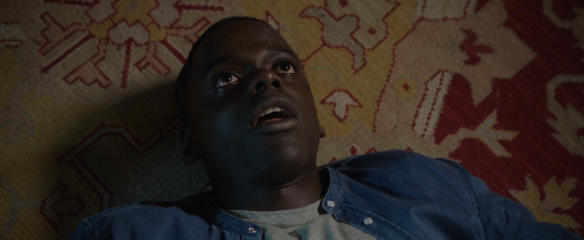 it is at this point that we once again are delivered, in a movie said to be so novel, of an evergreen trope, the assaulters encircling above, in a circle of heads, the felled assault victim, it is old as time in movies.
it is at this point that we once again are delivered, in a movie said to be so novel, of an evergreen trope, the assaulters encircling above, in a circle of heads, the felled assault victim, it is old as time in movies.
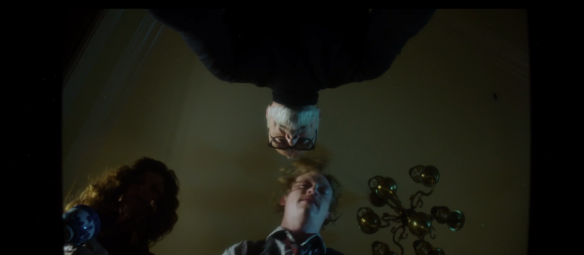 but the interesting thing is that the people themselves have to drop their disguises and reveal their true role as functionaries of a well-functioning family cult for delivery of harvested body cult to members of the cult for a price. There is dad, who is the head honcho, and deliverer, the surgeon; there is mom, who has the weapon of hypnotism which disables; there is the henchman, junior, who we saw in the opening prologue of the movie; and then, most surprisingly, there is innocent Rose, who in fact is a body snatcher, cult scout, parts supplier who uses her body and sexuality to get men close to her, bring them to the house, and then they kill them–all of this, on the grandfather’s template, having to do with black men. Interesting, she immediately, upon the stripping bare of the illusion, ties back her hair into a fiercer, workout pony tail, and becomes more like an avenging angel
but the interesting thing is that the people themselves have to drop their disguises and reveal their true role as functionaries of a well-functioning family cult for delivery of harvested body cult to members of the cult for a price. There is dad, who is the head honcho, and deliverer, the surgeon; there is mom, who has the weapon of hypnotism which disables; there is the henchman, junior, who we saw in the opening prologue of the movie; and then, most surprisingly, there is innocent Rose, who in fact is a body snatcher, cult scout, parts supplier who uses her body and sexuality to get men close to her, bring them to the house, and then they kill them–all of this, on the grandfather’s template, having to do with black men. Interesting, she immediately, upon the stripping bare of the illusion, ties back her hair into a fiercer, workout pony tail, and becomes more like an avenging angel
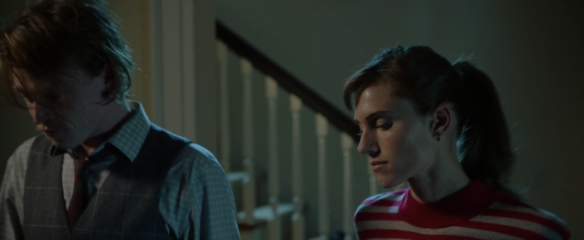 And in that posture, she is ready to play her part in the cult. Now, as hypnotized, the movie makes use of the effect of the hypnosis to visualize the sinking into the realization of his capture, as he whooshes down, away from all, the circle is there, as per trope
And in that posture, she is ready to play her part in the cult. Now, as hypnotized, the movie makes use of the effect of the hypnosis to visualize the sinking into the realization of his capture, as he whooshes down, away from all, the circle is there, as per trope
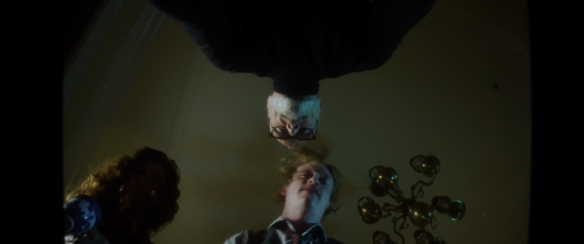 but his downward falling, all illusion of falling away, is dramatized
but his downward falling, all illusion of falling away, is dramatized
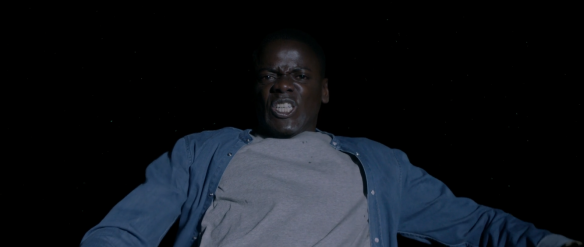 and now he falls down the whoosh, leaving them up above in the iris of the TV Set shot of the entoptic zone, as Rose calls down, You were one of my favorites, thanks, bitch
and now he falls down the whoosh, leaving them up above in the iris of the TV Set shot of the entoptic zone, as Rose calls down, You were one of my favorites, thanks, bitch
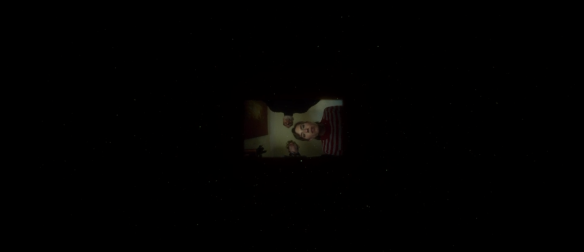 and, then, we get a very strange shot. It is from as it were a passing space ship, in the inner space where he floats, and we now see him down beneath, as if underwater, the space above where people live, there also appear to be stars, which metaphorically places him in outer as well as inner space
and, then, we get a very strange shot. It is from as it were a passing space ship, in the inner space where he floats, and we now see him down beneath, as if underwater, the space above where people live, there also appear to be stars, which metaphorically places him in outer as well as inner space
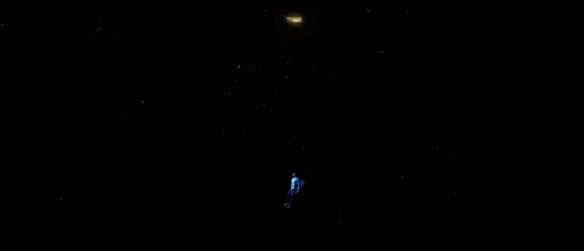 this shot more or less opens up the underworld, as it were, of the movie, and what that means is that it is at this point that the place he is placed in by hynposis in his mind is by ostension lateral to the dream state made real in both this world, and in a supernatural world below this world. In the physical realm, his underneathness is translated into being captured in the basement; the next level down will be his victimized participation in the surgery; and then his future fate, for he is not to be killed, is to live like the maid or gardener in a zombie subordinated state where as the blind art dealer says “a sliver of you will survive”, what the mom calls ‘the sunken place.” Though I wish she would have spelled out a bit more what this place is, it sounds to me like she has downshifted to a form of modern paganism where the dream state falls out of itself laterally into a physical adjunct space, which I have written of, and, in this case, materializes as a mental-physical space, adjacent to, and participant in, the waking world, but not really, for one is asleep, half of oneself, as a zombie. I have argued previously that the Romans had a dream theory whereby once you got to the bottom of it all, in deep dream state, you could pass through a door guarded by Mercury, to enter into the actual, physical underworld, where the dead rested or lived, and this appears to be a modernday equivalent, though I place it lateral and adjunct to the fourth level whoosh/spiral state, and not the fifth level REM deep dream state
this shot more or less opens up the underworld, as it were, of the movie, and what that means is that it is at this point that the place he is placed in by hynposis in his mind is by ostension lateral to the dream state made real in both this world, and in a supernatural world below this world. In the physical realm, his underneathness is translated into being captured in the basement; the next level down will be his victimized participation in the surgery; and then his future fate, for he is not to be killed, is to live like the maid or gardener in a zombie subordinated state where as the blind art dealer says “a sliver of you will survive”, what the mom calls ‘the sunken place.” Though I wish she would have spelled out a bit more what this place is, it sounds to me like she has downshifted to a form of modern paganism where the dream state falls out of itself laterally into a physical adjunct space, which I have written of, and, in this case, materializes as a mental-physical space, adjacent to, and participant in, the waking world, but not really, for one is asleep, half of oneself, as a zombie. I have argued previously that the Romans had a dream theory whereby once you got to the bottom of it all, in deep dream state, you could pass through a door guarded by Mercury, to enter into the actual, physical underworld, where the dead rested or lived, and this appears to be a modernday equivalent, though I place it lateral and adjunct to the fourth level whoosh/spiral state, and not the fifth level REM deep dream state
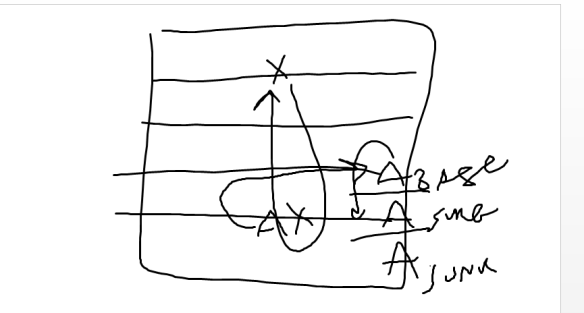
the basement is the first wrung of this hell, in my psychogeography, this occuring in an adjunct glass onion-to-lattice state, where the effects of the dream of hypnosis are made real in time and space, to him. So, the father uber alles is replaced by a deer buck head mounted on the wall
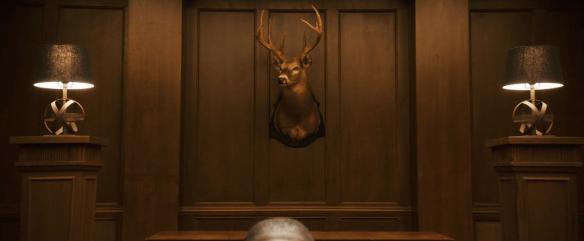 the deceptive traditionalism of the wall hangings are wiped away and replaced by contagious wood panelling, which by this point in history has so depleted that it means nothing less than death. This signifies that he is in a torture chamber, and is being held captive, there are so many variants of this same trope, the dungeon, that it hardly needs clarification, we are in familiar territory. But, then, the mother becomes the TV set, the generator of his hypnotized hypnagogic TV Set iris vision, now realized in real space, but, tellingly, inside a ritual space and routine magically established and attached to by the things of the grandfather, so it is not a new TV like people have mounted on their walls or mantels today, but an old style 60s color stereo, the kind we used to sit staring straight at, or on the floor, and it tells the story of the cult by way of some creepy old infomercial tape from the 60s or 70s
the deceptive traditionalism of the wall hangings are wiped away and replaced by contagious wood panelling, which by this point in history has so depleted that it means nothing less than death. This signifies that he is in a torture chamber, and is being held captive, there are so many variants of this same trope, the dungeon, that it hardly needs clarification, we are in familiar territory. But, then, the mother becomes the TV set, the generator of his hypnotized hypnagogic TV Set iris vision, now realized in real space, but, tellingly, inside a ritual space and routine magically established and attached to by the things of the grandfather, so it is not a new TV like people have mounted on their walls or mantels today, but an old style 60s color stereo, the kind we used to sit staring straight at, or on the floor, and it tells the story of the cult by way of some creepy old infomercial tape from the 60s or 70s
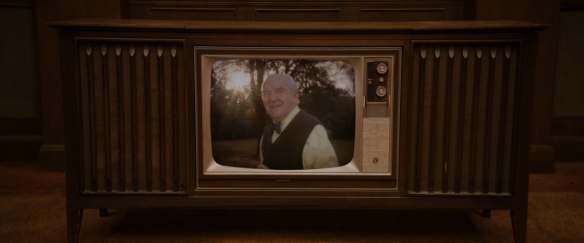 and it is in this context that we meet and see that in fact the grandfather was such a cult figure in the nature of a modern cultist like L. Ron Hubbard or the like, a stock figure in modern horror; that the son is a nerdy spineless subject, the wife a devoted handmaiden of the cult, and the children, including Rose, utterly brainwashed, all of them, in this picture, perhaps dated too far back in time for an image that could only be coming to us from the late 90s, if Rose is only 25ish, the cult
and it is in this context that we meet and see that in fact the grandfather was such a cult figure in the nature of a modern cultist like L. Ron Hubbard or the like, a stock figure in modern horror; that the son is a nerdy spineless subject, the wife a devoted handmaiden of the cult, and the children, including Rose, utterly brainwashed, all of them, in this picture, perhaps dated too far back in time for an image that could only be coming to us from the late 90s, if Rose is only 25ish, the cult
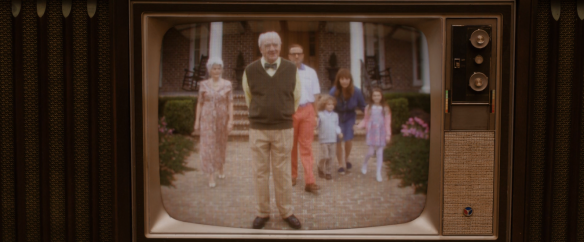 in this context we also see that the house used to be more normal, and was only spruced up to look plantational by the retrograde actions of the maturing minds of the son and wife
in this context we also see that the house used to be more normal, and was only spruced up to look plantational by the retrograde actions of the maturing minds of the son and wife
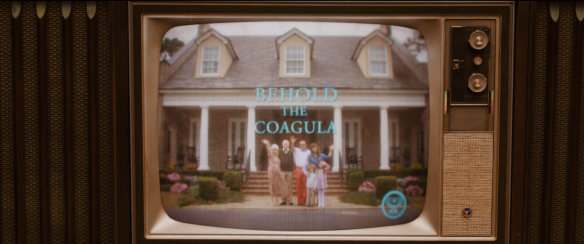 It is in the context of this explanation, the research section as it were of the movie, which is OK, though I would have liked more, that we get the full explanation for the wife’s role as enabler of the cult by having invented a type of hypnosis which not only sends people down the whoosh, to look and see the TV Set iris in the entoptic field of vision far above them, but, then, it is implied that through mad science passed by the grandfather to the dad a technique was developed whereby that hypnotized state could be physicalized as a process where parts were removed from the falling figure and transferred back to the body suspended in the TV Set iris and then the body left behind zombieized but alive to live forever after in a permanent waking dream state of “the sunken place”. This is pretty good stuff
It is in the context of this explanation, the research section as it were of the movie, which is OK, though I would have liked more, that we get the full explanation for the wife’s role as enabler of the cult by having invented a type of hypnosis which not only sends people down the whoosh, to look and see the TV Set iris in the entoptic field of vision far above them, but, then, it is implied that through mad science passed by the grandfather to the dad a technique was developed whereby that hypnotized state could be physicalized as a process where parts were removed from the falling figure and transferred back to the body suspended in the TV Set iris and then the body left behind zombieized but alive to live forever after in a permanent waking dream state of “the sunken place”. This is pretty good stuff
 (That said, in my view, the movie does fall down a bit in portraying too ersatzly the surgery and the set up which seems right out of Hammer Frankenstein movies, it doesn’t quite work
(That said, in my view, the movie does fall down a bit in portraying too ersatzly the surgery and the set up which seems right out of Hammer Frankenstein movies, it doesn’t quite work
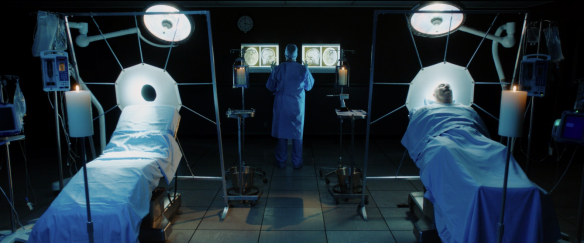 but what really interested me here is that in the past generation the evil basement with the rec room has morphed into the luxury mancave (we saw one again on Sunday in a house tour of the Barber House in Lincoln, which, by 1994, after 40 years of frat living, had been reduced to being uninhabitable, but now the basement is all entirely redone as a mancave lined with books and tvs), and what that means is that the cellardweller look that we get in 10 Cloverfield Road or other outings is replaced by luxury and the evil Jeffrey Dahmer taxiderm lair is also upgraded to almost seem like kunstkammer level art, it’s quite a set up
but what really interested me here is that in the past generation the evil basement with the rec room has morphed into the luxury mancave (we saw one again on Sunday in a house tour of the Barber House in Lincoln, which, by 1994, after 40 years of frat living, had been reduced to being uninhabitable, but now the basement is all entirely redone as a mancave lined with books and tvs), and what that means is that the cellardweller look that we get in 10 Cloverfield Road or other outings is replaced by luxury and the evil Jeffrey Dahmer taxiderm lair is also upgraded to almost seem like kunstkammer level art, it’s quite a set up
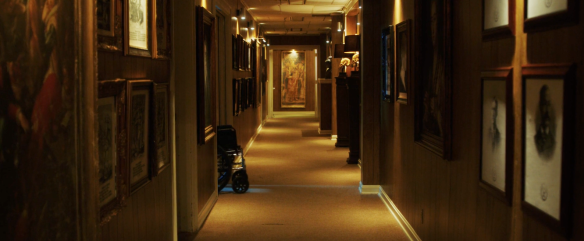 it is rare when we get a good look at the art here as it might profile the drama, and warn us of the troubles. We see that a good number of the pictures are, in the manner of The Shining, cult pictures of group meetings of the great old Anglo American glory days (pre-1950)
it is rare when we get a good look at the art here as it might profile the drama, and warn us of the troubles. We see that a good number of the pictures are, in the manner of The Shining, cult pictures of group meetings of the great old Anglo American glory days (pre-1950)
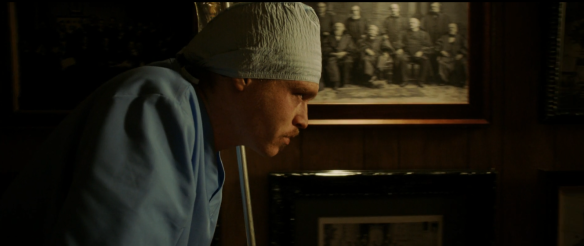 at another point, we see that there are ram’s skull lamps, also funerary or morbid in nature
at another point, we see that there are ram’s skull lamps, also funerary or morbid in nature
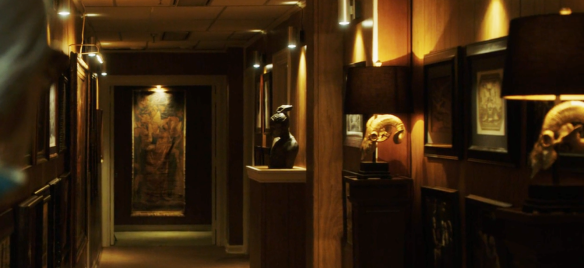 there seems to be some sort of quasi suit of armor-bronze head, with hand on it, just there as a strange object to alert and twist our mind, while the large panel at the end, while it looks like a Duchamp, is actually a large anatomical chart, of age-old use, going way back, good examples in The Gorgon (1966) and the Black Sleep (1956), so it is a fairly typical genre mad scientist lair where all the art is in fact expressive of his bodily impulse to sport with nature and make monsters, that is, dark kunsthammer art
there seems to be some sort of quasi suit of armor-bronze head, with hand on it, just there as a strange object to alert and twist our mind, while the large panel at the end, while it looks like a Duchamp, is actually a large anatomical chart, of age-old use, going way back, good examples in The Gorgon (1966) and the Black Sleep (1956), so it is a fairly typical genre mad scientist lair where all the art is in fact expressive of his bodily impulse to sport with nature and make monsters, that is, dark kunsthammer art
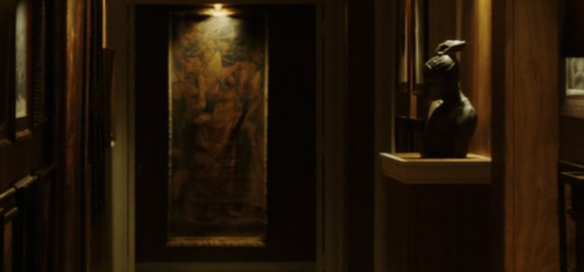 with many forerunners, and a Mary Shelley picture opposite, here is the chart at the end of the hall
with many forerunners, and a Mary Shelley picture opposite, here is the chart at the end of the hall
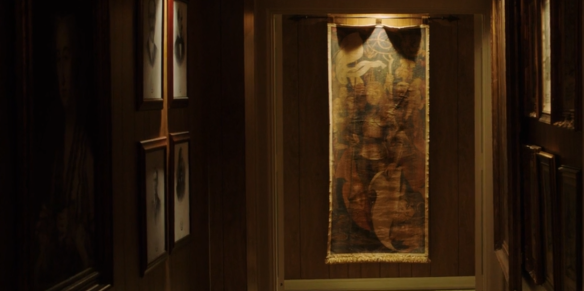 if you zero in, you see it is not quite an anatomical chart, though laid out aestheticaly like one, but appears to consist of some knights and ladies holding shields as if at the side audience section of a Van Eyck painting, but painted by Brugel, so, for me, an agentic painting of the German sort, with the purpose of a spell, signifying a dark mind
if you zero in, you see it is not quite an anatomical chart, though laid out aestheticaly like one, but appears to consist of some knights and ladies holding shields as if at the side audience section of a Van Eyck painting, but painted by Brugel, so, for me, an agentic painting of the German sort, with the purpose of a spell, signifying a dark mind
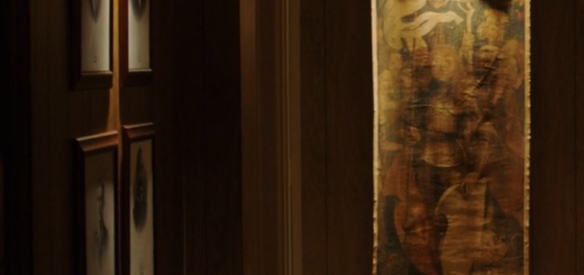 but then, even closer, it focuses as a possible “arma Christi” portrait of Christ armed in armor, the hero of the resurrection, it is in the model of arma christi meditation pictures, usually involving Christ getting scourged (though often abstracted to simply display the instruments of torture, to be meditated upon one by one, to put one in a state), but, somehow, in this version, the Resurrection has been superimposed over it, to show him smiling through it, in armor, like this picture, but in armor
but then, even closer, it focuses as a possible “arma Christi” portrait of Christ armed in armor, the hero of the resurrection, it is in the model of arma christi meditation pictures, usually involving Christ getting scourged (though often abstracted to simply display the instruments of torture, to be meditated upon one by one, to put one in a state), but, somehow, in this version, the Resurrection has been superimposed over it, to show him smiling through it, in armor, like this picture, but in armor
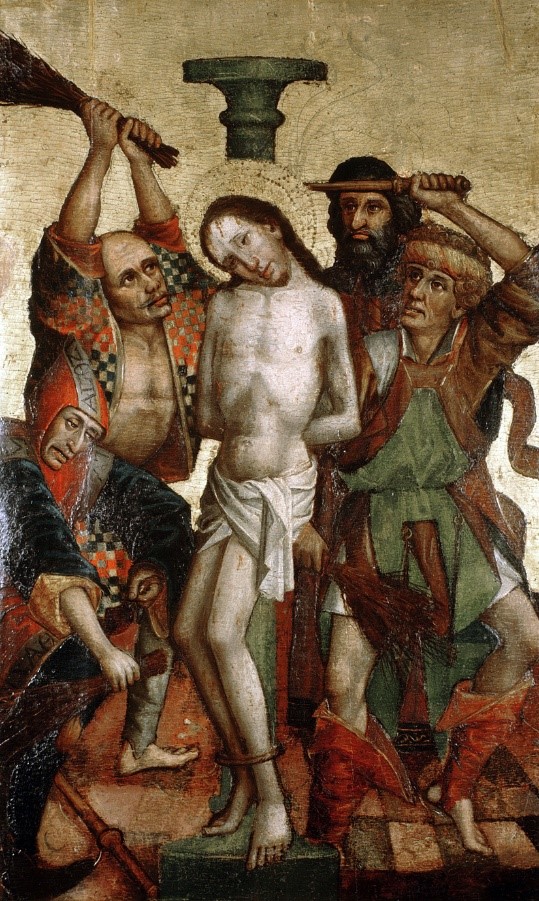
thus, this is, in the end, a cult picture of the activitiy of the cult, the agentic aesthetic of the how-to nature of an anatomical chart translated into a visual allegory to combine with the alibi formations of suits of armor to create an icon in the form of a dark personification of the activity of human sacrifice in the cult, perhaps, daily passing it, it helped dad to think, I’m doing holy work, for the future of mankind
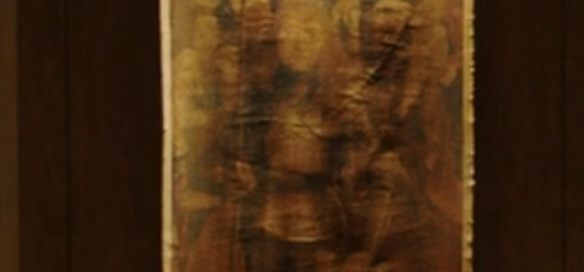 and the fact that the Christ on this shroudy thing looks like
and the fact that the Christ on this shroudy thing looks like
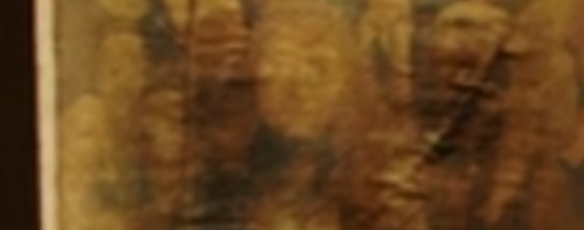 the blind art dealer who gets the eyes of Chris adds to the chill, though no one, except subliminally, actually sees this connection
the blind art dealer who gets the eyes of Chris adds to the chill, though no one, except subliminally, actually sees this connection
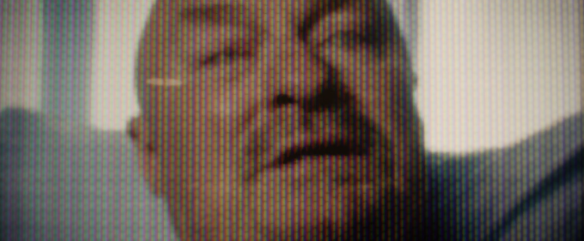 and then the arma christi element might simply be there to normalize into the weft of the mis en scene the somewhat throwaway Cronenberg vibe of the special instruments they have developed to undertake the surgery, somehow, who knows how, to get the transfer to occur (this too could’ve been better thought out and explained)
and then the arma christi element might simply be there to normalize into the weft of the mis en scene the somewhat throwaway Cronenberg vibe of the special instruments they have developed to undertake the surgery, somehow, who knows how, to get the transfer to occur (this too could’ve been better thought out and explained)
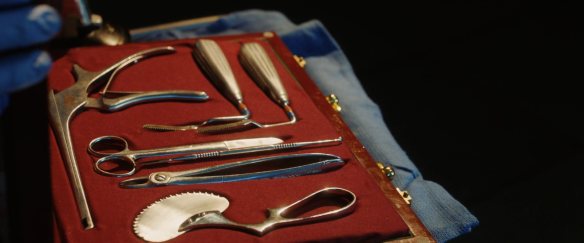 finally, coming out to see what’s holding up the son, we see that by the door there is also a large icon portrait of the master of the cult, maybe even the grandfather, like in The Wicker Man
finally, coming out to see what’s holding up the son, we see that by the door there is also a large icon portrait of the master of the cult, maybe even the grandfather, like in The Wicker Man
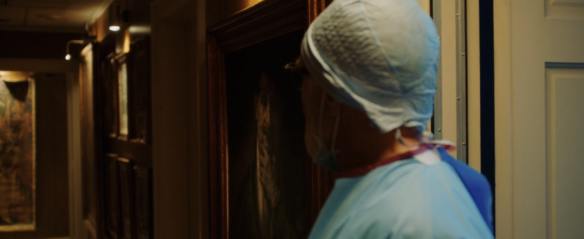 but it is precisely when he poses as the carrier on of the role of the icon in this generation, that he is skewered and killed, by a symbol of his victimizing others as trophies, the buck’s head
but it is precisely when he poses as the carrier on of the role of the icon in this generation, that he is skewered and killed, by a symbol of his victimizing others as trophies, the buck’s head
 in my view a bit too easily, but that’s that
in my view a bit too easily, but that’s that
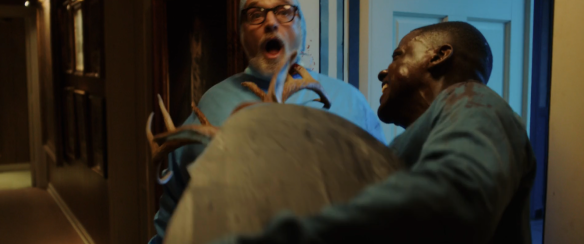 however, this is quite good use of the décor tropes of the basement lair. Taxidermy, of course, means that the master of the house is an exploiter. Everyone and everything is a trophy to him, Chris is a trophy that has been captured, for use now to continue the cult. The movie is quite good in making use of the instruments of horror in a basement lair. The carpet is rendered again as the too contagious surface of a polluted place, the walls all pannelled equals a padded cell, and then on the walls over the tv is the deer buck head trophy, which is the object made use of, the kill. It is a good idea, and possibly the best instrumentation of the deer head since Silent Night, Deadly Night (1985), where, a girl, running in the wood panelling of a country cabin
however, this is quite good use of the décor tropes of the basement lair. Taxidermy, of course, means that the master of the house is an exploiter. Everyone and everything is a trophy to him, Chris is a trophy that has been captured, for use now to continue the cult. The movie is quite good in making use of the instruments of horror in a basement lair. The carpet is rendered again as the too contagious surface of a polluted place, the walls all pannelled equals a padded cell, and then on the walls over the tv is the deer buck head trophy, which is the object made use of, the kill. It is a good idea, and possibly the best instrumentation of the deer head since Silent Night, Deadly Night (1985), where, a girl, running in the wood panelling of a country cabin
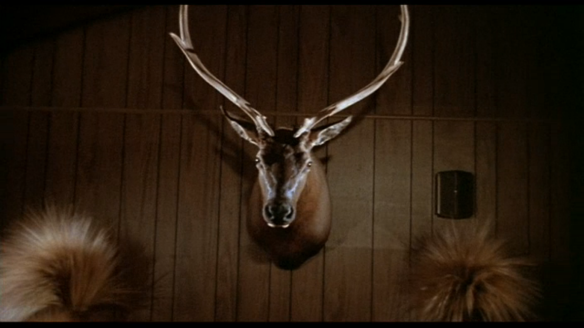 is lifted up
is lifted up
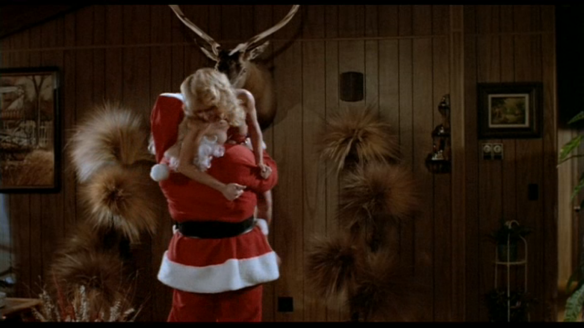 and skewered on the deer horns.
and skewered on the deer horns.
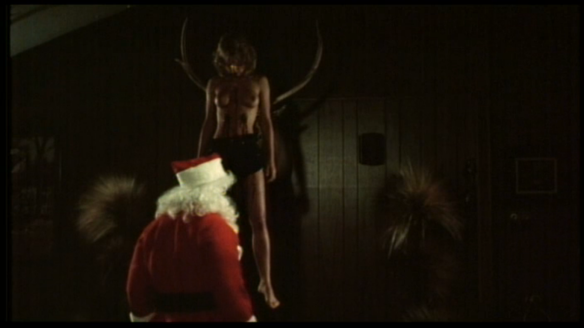 This reverses that, following the well-worn trope of wall décor objects being taken down and instrumentalized as weapons, it’s quite good. (It also signifies that just as 80s movies often built up horror by moving retrograde over tropes picked up in the 50s movies the directors etc watched when they were kids; it could be assumed that 10’s movies have also gone retrograde out of an impulse by directors now, who grew up in the 80s, to try to rework and redo tropes they first saw in the 80s, so it is the 80s times two (god help us). Then, when he is sure he has killed, he drops it
This reverses that, following the well-worn trope of wall décor objects being taken down and instrumentalized as weapons, it’s quite good. (It also signifies that just as 80s movies often built up horror by moving retrograde over tropes picked up in the 50s movies the directors etc watched when they were kids; it could be assumed that 10’s movies have also gone retrograde out of an impulse by directors now, who grew up in the 80s, to try to rework and redo tropes they first saw in the 80s, so it is the 80s times two (god help us). Then, when he is sure he has killed, he drops it
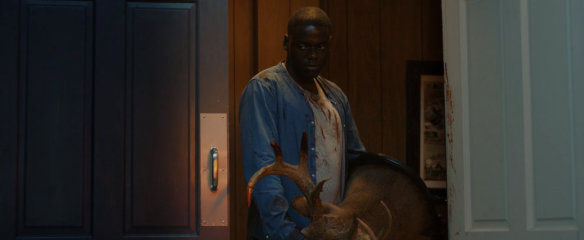 Nice genre scene shot here, dead body, dropped murder weapon, fire to destroy it all, and a strange allegorical alchemical print of the 17th century maybe which I cant make out but which was only meant to convey the idea that he had an alchemical mad science as well as kunstkammer imagination.
Nice genre scene shot here, dead body, dropped murder weapon, fire to destroy it all, and a strange allegorical alchemical print of the 17th century maybe which I cant make out but which was only meant to convey the idea that he had an alchemical mad science as well as kunstkammer imagination.
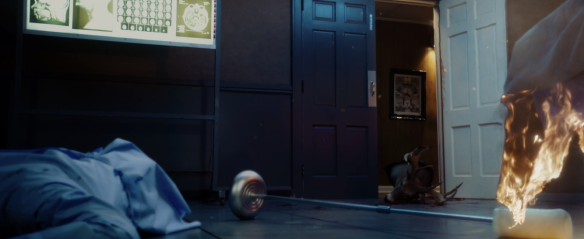 and finally he leaves, but he does so with the movie tossing in one more work. As Chris comes up the stairs, it is required that we, the viewer, so magic-slating away in our impulsive gaze, be instantly reminded that, it’s not over, trouble still lurks over head. We want to acknowledge the holy shit! craziness of what we just saw, but we also want to stay on the alert, because it’s not over. For that, a traffic cop picture is required, to serve as the herm as it were from the deep “sunken place” place, to return from that land of the dead from which he was never meant to return, to come back up, like Mercury opening the door of a Roman tomb on a sarcophagus, for him to be, not resurrected sickly as a surviving zombie from a transplant to advantage another, but to rise up again from an event that was sure to kill him, whole, to live again, and for this turn, this herm, this traffic cop juncture, the movie came up with Salvator Rosa’s Allergy of Fortune, which is not only flatly visually good because it is a bit witchy looking, and may warn us, the witches, mother and daugher are upstairs, but at the same time it spells out all the objects that were brought into play for him to get out, and expresses visual amazement in a momentary aha of excitement that he is still there
and finally he leaves, but he does so with the movie tossing in one more work. As Chris comes up the stairs, it is required that we, the viewer, so magic-slating away in our impulsive gaze, be instantly reminded that, it’s not over, trouble still lurks over head. We want to acknowledge the holy shit! craziness of what we just saw, but we also want to stay on the alert, because it’s not over. For that, a traffic cop picture is required, to serve as the herm as it were from the deep “sunken place” place, to return from that land of the dead from which he was never meant to return, to come back up, like Mercury opening the door of a Roman tomb on a sarcophagus, for him to be, not resurrected sickly as a surviving zombie from a transplant to advantage another, but to rise up again from an event that was sure to kill him, whole, to live again, and for this turn, this herm, this traffic cop juncture, the movie came up with Salvator Rosa’s Allergy of Fortune, which is not only flatly visually good because it is a bit witchy looking, and may warn us, the witches, mother and daugher are upstairs, but at the same time it spells out all the objects that were brought into play for him to get out, and expresses visual amazement in a momentary aha of excitement that he is still there
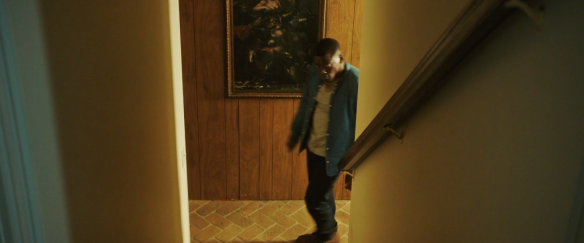 since the picture is not in any way dwelt on, or instrumentalized, but seen just in passing I think it would be giving it too much credit to delve into the background of what it actually means as a work of art and then apply that to the movie (apparently it was interpreted as a negative allegory of papal power, and almost got Rosa excommunicated and arrested, so it may have a protest vibe)
since the picture is not in any way dwelt on, or instrumentalized, but seen just in passing I think it would be giving it too much credit to delve into the background of what it actually means as a work of art and then apply that to the movie (apparently it was interpreted as a negative allegory of papal power, and almost got Rosa excommunicated and arrested, so it may have a protest vibe)
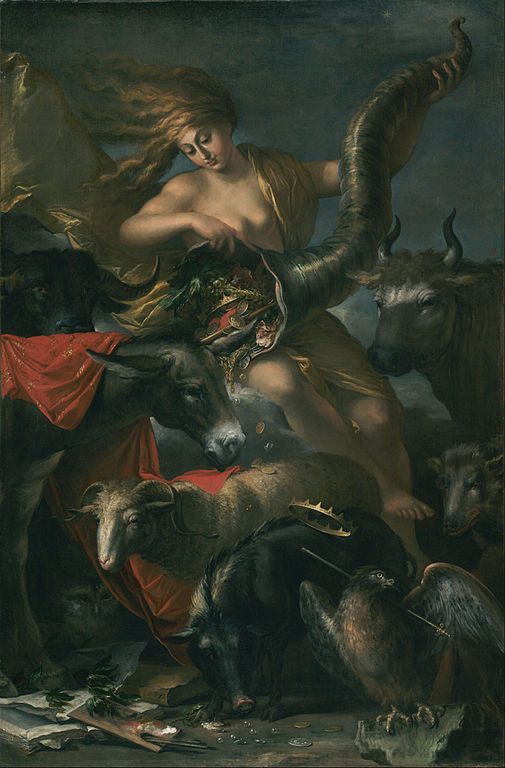
it might be Peele’s thesis picture, spelling out his overall purpose in writing this movie as he did, which definitely has a lot of double-edged swords, as I have pointed out, but it is there on screen for one second
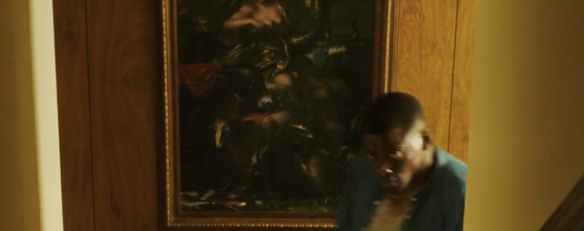 still the fact that that dark thing is looked at every day by the cult members going about their witchcraft and human sacrifice is a strong indicator of how sick they are, generally
still the fact that that dark thing is looked at every day by the cult members going about their witchcraft and human sacrifice is a strong indicator of how sick they are, generally
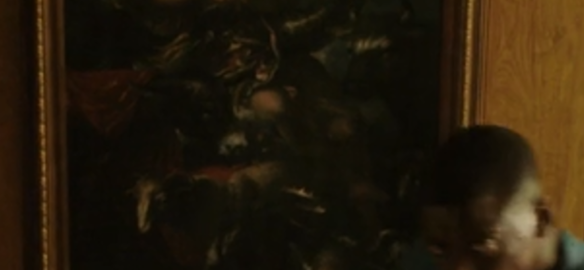 and then he escapes, though the strange thing about the breakout is that he plays the role of the Black Man home invader/intruder which is such a trope of terror movies about suburban neighborhoods, he just kills and kills and moves on, it is mayhem
and then he escapes, though the strange thing about the breakout is that he plays the role of the Black Man home invader/intruder which is such a trope of terror movies about suburban neighborhoods, he just kills and kills and moves on, it is mayhem
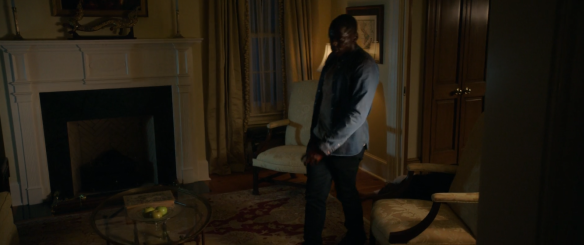 overall, however, Get Out (2017) does a nice job in modernizing and upping the class level of some of the evergreen horror tropes of mad scientist lairs in basements going way back to The Fly (1958) and beyond, and in evil surgeries designed to sacrifice one human being so that another can live. In truth, for all of its explicit attention, because of the issue of race, the movie is, like many of the Blumhouse movies, not out of keeping with the retrograde-domestic trend of American horror at the moment, it is low keyed, it is domestic, the supernatural is effaced in and under the natural, the extraordinary is hidden in the everyday, and even the evil mad scientist lair is hid in what anyone else coming through on a house tour like the one I took in Lincoln, Near South, on Sunday, would think, pretty normal house, except that his taste in art is rather weird. For all that, through the instrumentation of the tropes and pictures of the secret sunken place, Get Out is pretty darn good.
overall, however, Get Out (2017) does a nice job in modernizing and upping the class level of some of the evergreen horror tropes of mad scientist lairs in basements going way back to The Fly (1958) and beyond, and in evil surgeries designed to sacrifice one human being so that another can live. In truth, for all of its explicit attention, because of the issue of race, the movie is, like many of the Blumhouse movies, not out of keeping with the retrograde-domestic trend of American horror at the moment, it is low keyed, it is domestic, the supernatural is effaced in and under the natural, the extraordinary is hidden in the everyday, and even the evil mad scientist lair is hid in what anyone else coming through on a house tour like the one I took in Lincoln, Near South, on Sunday, would think, pretty normal house, except that his taste in art is rather weird. For all that, through the instrumentation of the tropes and pictures of the secret sunken place, Get Out is pretty darn good.
Overall, then, as spelled out in this impromptu review of Get Out (2017), it has very solid strengths, but perhaps the most convincing proof of how well it embedded evergreen tropes into a domestic drama orientation for most audiences to attend it as that, but then have to deal with its darker side, its aspect as a horror movie, and not a social commentary movie, not even mentioned by reviews I read in the New York Times or The Guardian, is that most people simply do not pick up the clever and clearly informed use of the tropes, their swell instrumentation, and the making, below the racial hype, of a classicly made, beautifully worked out, evil cult Anglos seeking eternal life human sacrifice horror movie.

 so had people come in by the side door, to get a bit of the African American perspective on such structures. Well, the house in Get Out also is modelled on Jefferson’s Monticello
so had people come in by the side door, to get a bit of the African American perspective on such structures. Well, the house in Get Out also is modelled on Jefferson’s Monticello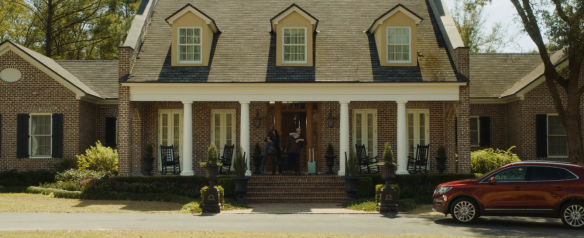 and not only are the first hugs of the greeting sequence cast into a long shot, so that a standard trope is effaced, but then the camera pulls back to frame it in the back and eye of the African American gardener, to, as it were, frame the movie as the lattice-level nightmare of the average African American. This would seem, by itself, to place the gaze of the audience in, specifically, the African American mindset, but it is also true it could be a critique of the retrograde motion in race debate in this country in which an assimilative model of civil rights and progress appears to have been replaced by a rollback to a plantation view of the races, African Americans, according to this rhetoric, having made no progress since the end of the Civil War, and that’s what this is.
and not only are the first hugs of the greeting sequence cast into a long shot, so that a standard trope is effaced, but then the camera pulls back to frame it in the back and eye of the African American gardener, to, as it were, frame the movie as the lattice-level nightmare of the average African American. This would seem, by itself, to place the gaze of the audience in, specifically, the African American mindset, but it is also true it could be a critique of the retrograde motion in race debate in this country in which an assimilative model of civil rights and progress appears to have been replaced by a rollback to a plantation view of the races, African Americans, according to this rhetoric, having made no progress since the end of the Civil War, and that’s what this is.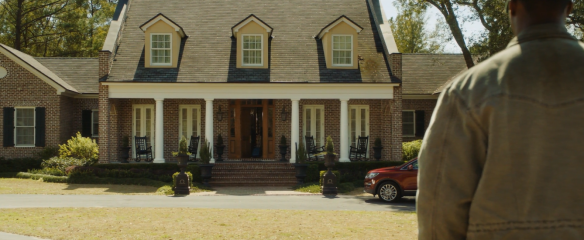 the trouble in the house begins almost as soon as Chris gets in the door, as, as it were, and this same visual effect was made use of in Frankenstein (1931) to characterize trouble resounding through the house, top to bottom, the greeting continues to be cast in the background, and effaced, as the camera now follows the greeters and greeted from the front hall
the trouble in the house begins almost as soon as Chris gets in the door, as, as it were, and this same visual effect was made use of in Frankenstein (1931) to characterize trouble resounding through the house, top to bottom, the greeting continues to be cast in the background, and effaced, as the camera now follows the greeters and greeted from the front hall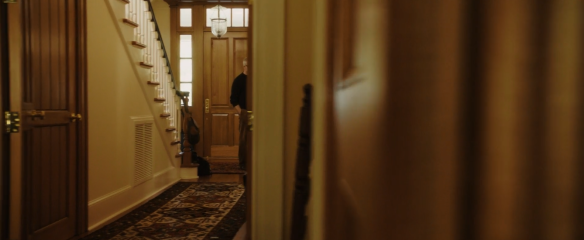 through the book case in the other room, meaning that the house reads too, and may harbor kooky theories
through the book case in the other room, meaning that the house reads too, and may harbor kooky theories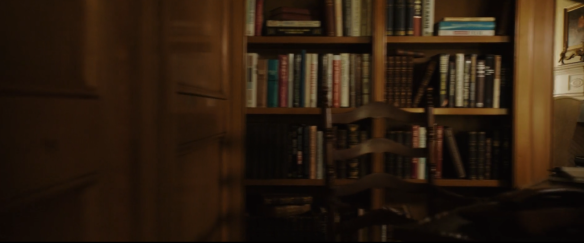 out to the living room, but not before showing us the backs of several family pictures mounted in frames on the piano, I suppose, all of which blacks out and effaces the actual family history, for a fake one
out to the living room, but not before showing us the backs of several family pictures mounted in frames on the piano, I suppose, all of which blacks out and effaces the actual family history, for a fake one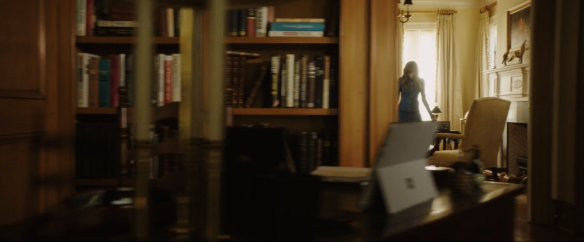 and then when they sit down, it is all but in the embrace of the patriarch, represented by a menacing old painting in oval form of the ancestor of the family
and then when they sit down, it is all but in the embrace of the patriarch, represented by a menacing old painting in oval form of the ancestor of the family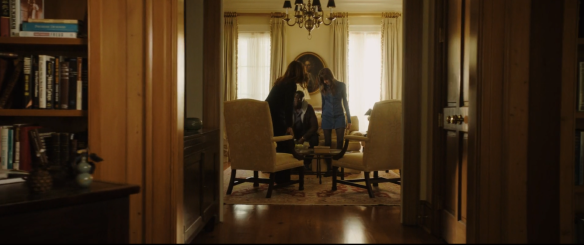 one would normally think of a picture like this as a flea market find put up for purely aesthetic-nostalgic reasons, but the fact that it embraces the two as they sit, means that it is an important prototype, and that the mother and father actually believe in him, and take marching orders from him
one would normally think of a picture like this as a flea market find put up for purely aesthetic-nostalgic reasons, but the fact that it embraces the two as they sit, means that it is an important prototype, and that the mother and father actually believe in him, and take marching orders from him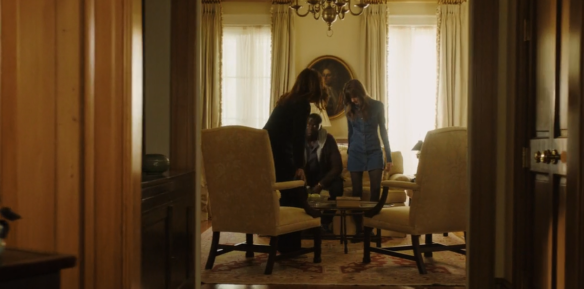 then not two minutes into it, the interrogation begins, and things get uncomfortable. The fact that Whitford is profiled by another picture, this time of a boy, which makes this, unofficially, a blue boy picture, adds to the drama the idea that he is interrogating Chris not out of concern for him, for as a young man in a house with a blue boy picture Chris is declared already to be in trouble, but for the sake of the family line, its blood and lineage. A blue boy picture is any antique picture of a young man or boy in a house, all of which, especially if placed in a spray of family pictures, in a parade of pictures, means that the boy of the house is in trouble, and, indeed, the whole family line is in trouble
then not two minutes into it, the interrogation begins, and things get uncomfortable. The fact that Whitford is profiled by another picture, this time of a boy, which makes this, unofficially, a blue boy picture, adds to the drama the idea that he is interrogating Chris not out of concern for him, for as a young man in a house with a blue boy picture Chris is declared already to be in trouble, but for the sake of the family line, its blood and lineage. A blue boy picture is any antique picture of a young man or boy in a house, all of which, especially if placed in a spray of family pictures, in a parade of pictures, means that the boy of the house is in trouble, and, indeed, the whole family line is in trouble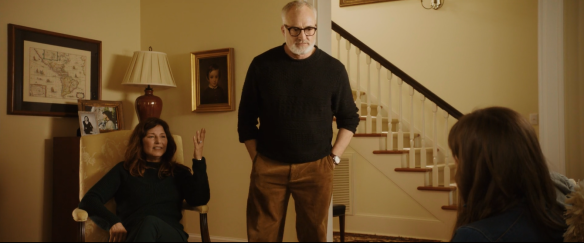 These things don’t mean anything? Well, they do, apparently, to Peele, because now he doubles up on the trope of the cringing welcome, to the much more famous, and satisfyingly deep, trope of the haunted portrait parade. In this case, this parade is slightly displaced, to efface connection with the ancestors, but it is still worked out nonetheless by way of family pictures being given way too much wall space in the home. We are going to see a lot of antifeminist imagery in the domestic imagery, and we get that first thing as we write off the women folk as the lions or tigers of the cage, with no real power other than as bouncers or killers
These things don’t mean anything? Well, they do, apparently, to Peele, because now he doubles up on the trope of the cringing welcome, to the much more famous, and satisfyingly deep, trope of the haunted portrait parade. In this case, this parade is slightly displaced, to efface connection with the ancestors, but it is still worked out nonetheless by way of family pictures being given way too much wall space in the home. We are going to see a lot of antifeminist imagery in the domestic imagery, and we get that first thing as we write off the women folk as the lions or tigers of the cage, with no real power other than as bouncers or killers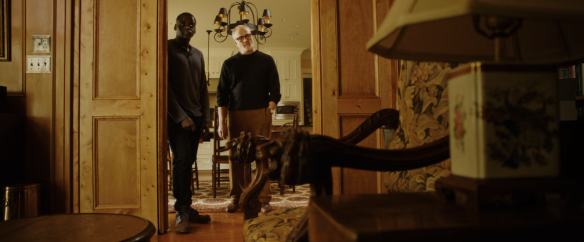 but then in the hallway, not ten minutes in the house, he gets right into it, we see the culprit, the problem, the reveal and source of the whole drama in the movie, the family picture of dad, and then the married couple when young, and the kids when young
but then in the hallway, not ten minutes in the house, he gets right into it, we see the culprit, the problem, the reveal and source of the whole drama in the movie, the family picture of dad, and then the married couple when young, and the kids when young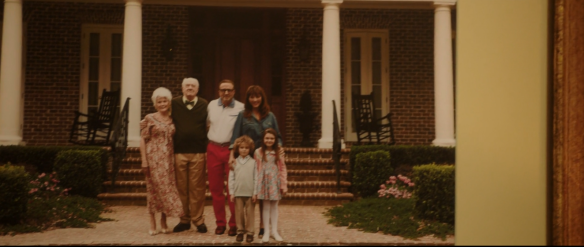 and this picture is enshrined as it were the middle of a typical family picture shrine, which always signals that the family is paying way too much attention to its power
and this picture is enshrined as it were the middle of a typical family picture shrine, which always signals that the family is paying way too much attention to its power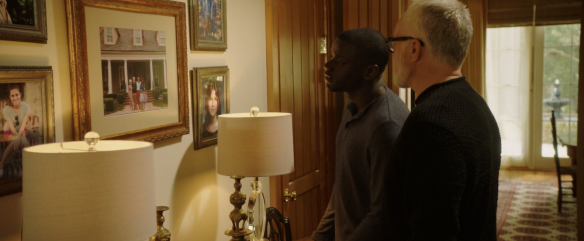 then, a really weird, and regressive thing, is that Rose hands him over to dad, and the men go through the history, like it is a guy thing, and, then, as they proceed, they already having been separated, she shows up on the tour, having unplugged, and being involved in other ways with other people, and with a globe behind her
then, a really weird, and regressive thing, is that Rose hands him over to dad, and the men go through the history, like it is a guy thing, and, then, as they proceed, they already having been separated, she shows up on the tour, having unplugged, and being involved in other ways with other people, and with a globe behind her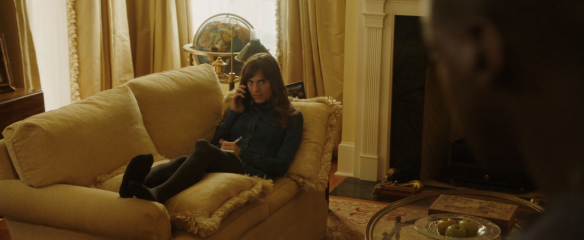 of course, there is no chance that anyone is going to see this, on first viewing, but it is to be noted that we have just seen Rose as a little girl embosomed in the blue denim breast of her mother, a dutiful little good girl, and now we see her come alive in 3D in the middle of the family parade, with a globe behind her, same thing
of course, there is no chance that anyone is going to see this, on first viewing, but it is to be noted that we have just seen Rose as a little girl embosomed in the blue denim breast of her mother, a dutiful little good girl, and now we see her come alive in 3D in the middle of the family parade, with a globe behind her, same thing then in the dining room, there is a weird landscape painting, that means trouble is coming, and it is identified with the dad
then in the dining room, there is a weird landscape painting, that means trouble is coming, and it is identified with the dad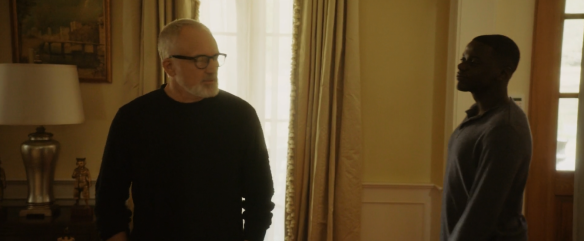 and then while the tour continues we see deer, bucks, evoking trophies, if not exactly taxidermy, then certainly still working the trope as indicative of a warning that the man of the house is an exploiter and abuser, beware
and then while the tour continues we see deer, bucks, evoking trophies, if not exactly taxidermy, then certainly still working the trope as indicative of a warning that the man of the house is an exploiter and abuser, beware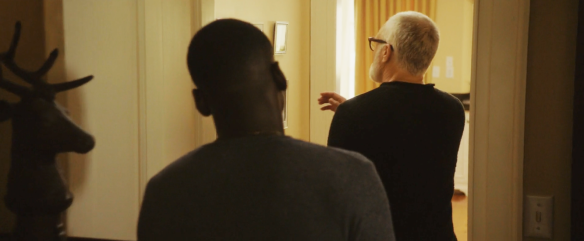 even weirder is that when we are introduced to the housekeeper she is standing in the kitchen as if a robot, part of the furniture, and the lattice shot here again picks up on the shot of the house from the gardener’s POV to act as a lattice to infer that inside his head everything about this is about race, and not only that but it almost sick and nemesis-oriented that it does seem as if everything is pointedly about race, to make him feel uncomfortable
even weirder is that when we are introduced to the housekeeper she is standing in the kitchen as if a robot, part of the furniture, and the lattice shot here again picks up on the shot of the house from the gardener’s POV to act as a lattice to infer that inside his head everything about this is about race, and not only that but it almost sick and nemesis-oriented that it does seem as if everything is pointedly about race, to make him feel uncomfortable and then we come to the primary artifact of the family portrait parade, and the actual haunted portrait of the movie, if in a modern photo form, a picture of the dad as an Olympic athlete that lost out in the trials in 1936 to Jesse Owens. Normally, that event in modern history is taken as a good sign of American inclusivity against the racism of the Nazi sort, and as a comparable, if not perfect, dismissal of race theory and rebuttal of Hitler’s rhetoric, by proving that Americans, and black Americans, are better athletes. The other side of it, except reports that Hitler was upset, is rarely told. But I suppose Owens did beat out some white runners, and, for that, took some racial flack. And one case would by Whitford’s dad, the patriarch, who might’ve been a eugenics believer at the time, and this for him turned out to be the turning point of his life, from which he curdled in bitterness to find a solution to white weakness so that this would never happen again, and so he developed his late-in-the-day demented eugenics cult in which by means of a surgical procedure of transplantation or organ harvesting from lesser people, the group is granted immortality, while the donors are reduced to zombies living in the sunken place. From this incident, the dad’s dad, who we saw in the picture, launched a career as a genetic cultist who preached a message of racial purity and living forever, but only for exclusive members of his club, and the family. This is funny, and strange, and very sharp. That this emblematic progressive incident is turned upside down to become the negative catalyst of a curling into virulent racism against others is quite good. And since Owens happened to be black, and the disappointment happened to dad, from him, the subsequent science focuses on black people forever after, and that is the message.
and then we come to the primary artifact of the family portrait parade, and the actual haunted portrait of the movie, if in a modern photo form, a picture of the dad as an Olympic athlete that lost out in the trials in 1936 to Jesse Owens. Normally, that event in modern history is taken as a good sign of American inclusivity against the racism of the Nazi sort, and as a comparable, if not perfect, dismissal of race theory and rebuttal of Hitler’s rhetoric, by proving that Americans, and black Americans, are better athletes. The other side of it, except reports that Hitler was upset, is rarely told. But I suppose Owens did beat out some white runners, and, for that, took some racial flack. And one case would by Whitford’s dad, the patriarch, who might’ve been a eugenics believer at the time, and this for him turned out to be the turning point of his life, from which he curdled in bitterness to find a solution to white weakness so that this would never happen again, and so he developed his late-in-the-day demented eugenics cult in which by means of a surgical procedure of transplantation or organ harvesting from lesser people, the group is granted immortality, while the donors are reduced to zombies living in the sunken place. From this incident, the dad’s dad, who we saw in the picture, launched a career as a genetic cultist who preached a message of racial purity and living forever, but only for exclusive members of his club, and the family. This is funny, and strange, and very sharp. That this emblematic progressive incident is turned upside down to become the negative catalyst of a curling into virulent racism against others is quite good. And since Owens happened to be black, and the disappointment happened to dad, from him, the subsequent science focuses on black people forever after, and that is the message.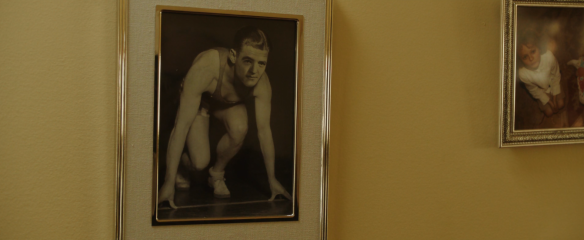 In the movie’s funniest line, Witford says, “he almost got over it”, meaning he did not, and he, of course, lives in the nightmare of his father having never got over it (though he is no Hamlet, in fact submits utterly to the father’s cult). So, this is an entirely hidden-in-norm and somewhat effaced, but also entirely traditional haunted portrait parade, in which we find out that the house is haunted by the dad’s dad’s disappointment and they are not really a family but a cult dedicated to life immortal, gained by harvesting body organs from forced and kidnapped donors. It’s quite good, and fun, though only afficianados of the drama will know they have just watched a highly ritualized activity (examples that occur to be are Woman Who Came Back (1946), The Phantom of Crestwood (1931), etc; Thirst (1985); Society (1989)).
In the movie’s funniest line, Witford says, “he almost got over it”, meaning he did not, and he, of course, lives in the nightmare of his father having never got over it (though he is no Hamlet, in fact submits utterly to the father’s cult). So, this is an entirely hidden-in-norm and somewhat effaced, but also entirely traditional haunted portrait parade, in which we find out that the house is haunted by the dad’s dad’s disappointment and they are not really a family but a cult dedicated to life immortal, gained by harvesting body organs from forced and kidnapped donors. It’s quite good, and fun, though only afficianados of the drama will know they have just watched a highly ritualized activity (examples that occur to be are Woman Who Came Back (1946), The Phantom of Crestwood (1931), etc; Thirst (1985); Society (1989)).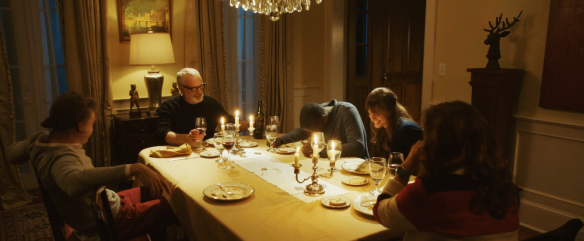 and though this display is entirely in convention, it is also true that Whitford defers to the son, to let him be the asshole, and ask all the tough questions, Alison plays at being upset
and though this display is entirely in convention, it is also true that Whitford defers to the son, to let him be the asshole, and ask all the tough questions, Alison plays at being upset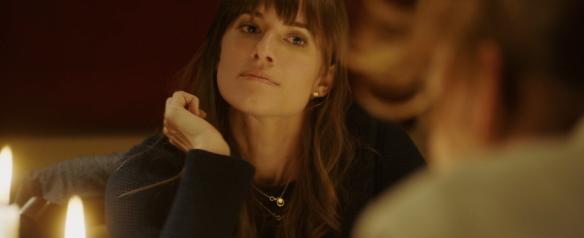 but, there is something very curious here, the picture behind the father
but, there is something very curious here, the picture behind the father when I saw this, I, in conventional fashion, thought, a landscape painting, that means trouble, trouble is coming to the house. But, there is a problem. Not only is it profiled by a chandelier, it is lit up by a lamp stood in front of it, from below, so lit up large, but also, it is flanked by two figures below, and, besides, it looks familiar. It looks, somehow, like a landscape painting, but not a landscape painting, like a landscape painting that tried to be that, but wasn’t. And then it struck me, that is Giorgione’s Tempest!
when I saw this, I, in conventional fashion, thought, a landscape painting, that means trouble, trouble is coming to the house. But, there is a problem. Not only is it profiled by a chandelier, it is lit up by a lamp stood in front of it, from below, so lit up large, but also, it is flanked by two figures below, and, besides, it looks familiar. It looks, somehow, like a landscape painting, but not a landscape painting, like a landscape painting that tried to be that, but wasn’t. And then it struck me, that is Giorgione’s Tempest!
 and here is the comparison
and here is the comparison in my view, there is no question, it is the same painting, but, then, the question is, why? why place this landscape, firstly, in back of the man at the table, when that is not the norm, then, why a Giorgione, and why an altered Giorgione? A few answers. First answers have to derive from the fact that in the diegetic sense, inside the movie, dad knew exactly what he was looking at, and, finding it at a thrift shop, bought it as is because it reminded him of the original; or, maybe, dad is a connoisseur of Renaissance art and rich enough that when he discovered that Giorgione or his studio had made landscape studies, he was able to purchase one; or he just got some painting shop to paint one up, on the cheap, then cut out the figures, because he just liked the landscape part. On the nondiegetic stage, outside the movie, it may be that the art directors meant absolutely nothing by this, it was just a landscape; if they knew about the trope of landscape spelling trouble, then it did that; if they knew about the trope of landscapes split down the middle by winding roads or rivers, meaning the primrose path, and that deception is happening in the visual scene on camera at the moment, then it does that too. But they had to also know that someone like Robert Mahoney was going to pick up on the Giorgione vibe, and thus add that in. And then the questions are, why did the dad see that it was necessary to alter the painting in this way? Perhaps it is, back to the diegetic, intentionally symbolic for the dad. The picture is said to represent in a baroque way the flight into Egypt. The nude is the Virgin Mary, and then the guard is the Roman searching for her. The storm symbolizes the birth of Christianity, and the fallen or half pillar represents the knocking down of the pillars and all the pagan idols when Christ as baby entered the city of Hermopolis. Typologically, the storm could also represent the plagues of Egypt, which the second coming is going to free the Jews and all from all over again. It may be theorized that Whitford in his cult disowned Christianity by displacing from Christ the myth of resurrection to try to find the same in a science-based cult of immortality by way of harvesting body parts (midcentury eugenics cults disowned, like the Nazis, the weak scapegoat religion of the Judeao-christian tradition, in favor of a faith in a god of strength). It might also be that this effacement refers to the curse, in the context of a negative mythology, placed upon gypsies and other low lifes by Christ for not helping him out as a child in Egypt, cursing them, thus, he in his power as dad, is doomed to curse any minority that enters into his spiderweb. It is a very complicated picture, but at present I will say that it is a cult procedural picture to remind him on a daily basis of what he is up to and about, without bringing any attention to it, or likely having to explain to anyone, except maybe me, when I ask him, why did you cut the figures out of the Giorigone?
in my view, there is no question, it is the same painting, but, then, the question is, why? why place this landscape, firstly, in back of the man at the table, when that is not the norm, then, why a Giorgione, and why an altered Giorgione? A few answers. First answers have to derive from the fact that in the diegetic sense, inside the movie, dad knew exactly what he was looking at, and, finding it at a thrift shop, bought it as is because it reminded him of the original; or, maybe, dad is a connoisseur of Renaissance art and rich enough that when he discovered that Giorgione or his studio had made landscape studies, he was able to purchase one; or he just got some painting shop to paint one up, on the cheap, then cut out the figures, because he just liked the landscape part. On the nondiegetic stage, outside the movie, it may be that the art directors meant absolutely nothing by this, it was just a landscape; if they knew about the trope of landscape spelling trouble, then it did that; if they knew about the trope of landscapes split down the middle by winding roads or rivers, meaning the primrose path, and that deception is happening in the visual scene on camera at the moment, then it does that too. But they had to also know that someone like Robert Mahoney was going to pick up on the Giorgione vibe, and thus add that in. And then the questions are, why did the dad see that it was necessary to alter the painting in this way? Perhaps it is, back to the diegetic, intentionally symbolic for the dad. The picture is said to represent in a baroque way the flight into Egypt. The nude is the Virgin Mary, and then the guard is the Roman searching for her. The storm symbolizes the birth of Christianity, and the fallen or half pillar represents the knocking down of the pillars and all the pagan idols when Christ as baby entered the city of Hermopolis. Typologically, the storm could also represent the plagues of Egypt, which the second coming is going to free the Jews and all from all over again. It may be theorized that Whitford in his cult disowned Christianity by displacing from Christ the myth of resurrection to try to find the same in a science-based cult of immortality by way of harvesting body parts (midcentury eugenics cults disowned, like the Nazis, the weak scapegoat religion of the Judeao-christian tradition, in favor of a faith in a god of strength). It might also be that this effacement refers to the curse, in the context of a negative mythology, placed upon gypsies and other low lifes by Christ for not helping him out as a child in Egypt, cursing them, thus, he in his power as dad, is doomed to curse any minority that enters into his spiderweb. It is a very complicated picture, but at present I will say that it is a cult procedural picture to remind him on a daily basis of what he is up to and about, without bringing any attention to it, or likely having to explain to anyone, except maybe me, when I ask him, why did you cut the figures out of the Giorigone?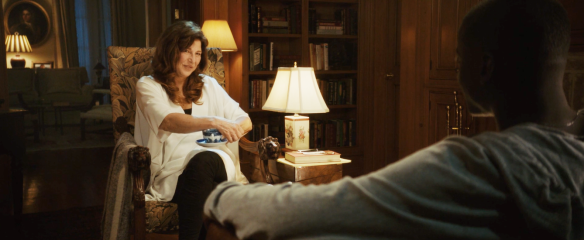 in this state, picturing continues, and, when hypnotized, Chris is amazed to find that in his mind he floats down to a weird state, which we later find out is called the sunken place.
in this state, picturing continues, and, when hypnotized, Chris is amazed to find that in his mind he floats down to a weird state, which we later find out is called the sunken place.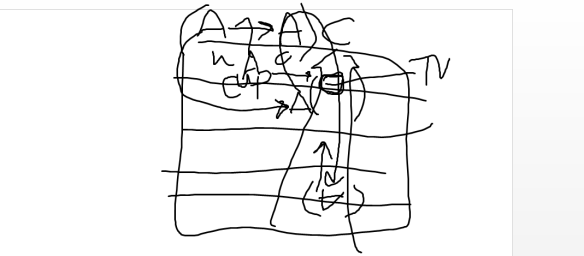
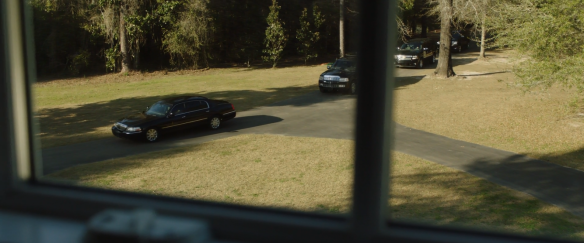 this is made apparent when he tries to break away, but walks right back into the picture row of the family cult
this is made apparent when he tries to break away, but walks right back into the picture row of the family cult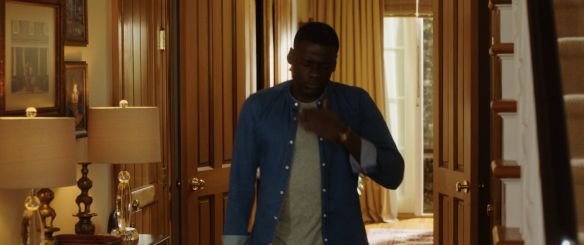 and then all the guests give away that they are all there for him, to bid on him, and are only there to watch and appraise him, and his worth as a donor
and then all the guests give away that they are all there for him, to bid on him, and are only there to watch and appraise him, and his worth as a donor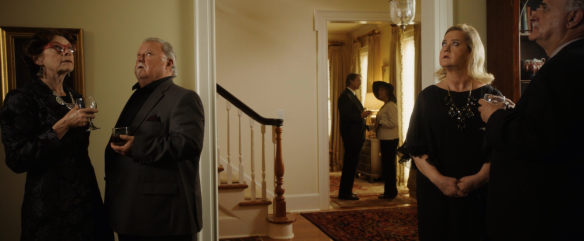 it is at this point that another landscape comes into the picture, entirely blacked out, on the stairs, indicating the black out out of his control phase
it is at this point that another landscape comes into the picture, entirely blacked out, on the stairs, indicating the black out out of his control phase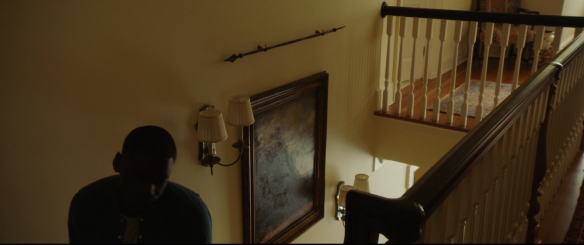 when Rose wonders where he is and is sent to wrangle him back into the mood because the produce must be displayed, in order to bid on it, she too is effaced in front of it, also showing some skin, but at this point most viewers still think she is the sympathetic girlfriend in a replay of Guess Who’s Coming to Dinner
when Rose wonders where he is and is sent to wrangle him back into the mood because the produce must be displayed, in order to bid on it, she too is effaced in front of it, also showing some skin, but at this point most viewers still think she is the sympathetic girlfriend in a replay of Guess Who’s Coming to Dinner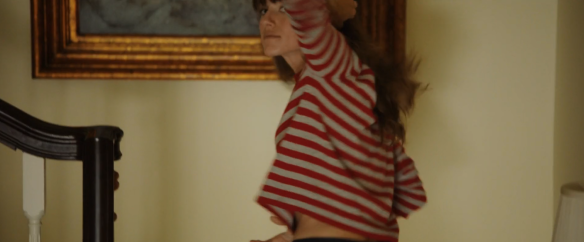 this shot, staring right at the clients, and the camera, and at us, would seem to give away her guilt, for it profiles her with a dark landscape evoking fear and deception and her dark heart
this shot, staring right at the clients, and the camera, and at us, would seem to give away her guilt, for it profiles her with a dark landscape evoking fear and deception and her dark heart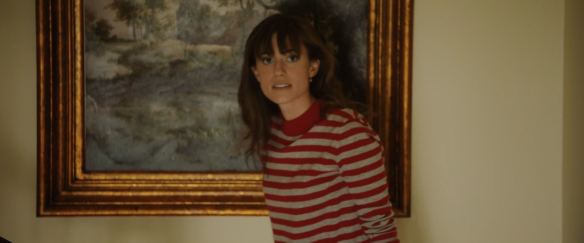 this is the first scene where her patience as the understanding girlfriend seems to shift to the other side, in defense of her family, she is upset, and in her room, still more of the strange obsessive cult of the family, pictures all over her dresser (I have decided that the picture on the right side is a meaningless punk image)
this is the first scene where her patience as the understanding girlfriend seems to shift to the other side, in defense of her family, she is upset, and in her room, still more of the strange obsessive cult of the family, pictures all over her dresser (I have decided that the picture on the right side is a meaningless punk image)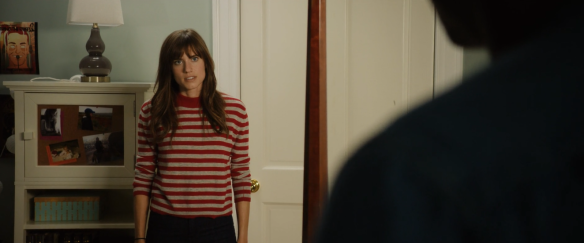 then in standard mirror play going way back, he looks one way, in one reality, she now walks in another, in reflection, walking away, a split has occurred
then in standard mirror play going way back, he looks one way, in one reality, she now walks in another, in reflection, walking away, a split has occurred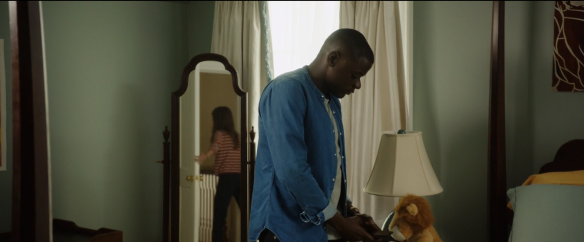 but then her job is to take him down to the river, through the landscape painting on the landing, to calm him down, and preoccupy him
but then her job is to take him down to the river, through the landscape painting on the landing, to calm him down, and preoccupy him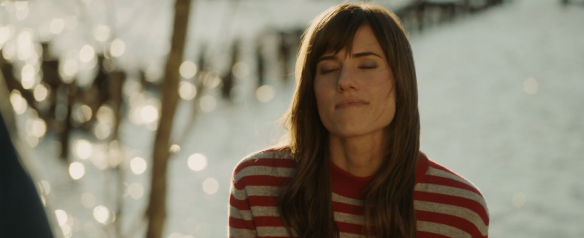 while his image shows up in another place in the movie, and that is at the gazebo where the main event of the cult day takes place, the auction for his body parts.
while his image shows up in another place in the movie, and that is at the gazebo where the main event of the cult day takes place, the auction for his body parts.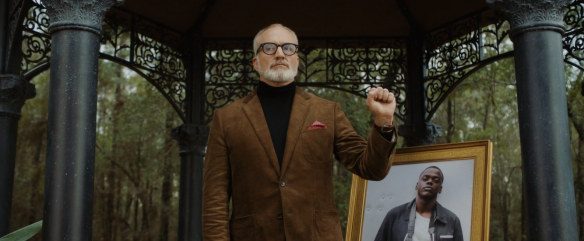 the movie has made much of the fact, in the parade of haunted portraits, that dad is stuck in the past, as is mom, and they all carry on rituals created in the modern era, by the grandparents. It was no doubt in that era that dad devised an auction making use of bingo as the way to go, giving the proceedings a sort of Ouija board quality, but fun too, in a retrograde way.
the movie has made much of the fact, in the parade of haunted portraits, that dad is stuck in the past, as is mom, and they all carry on rituals created in the modern era, by the grandparents. It was no doubt in that era that dad devised an auction making use of bingo as the way to go, giving the proceedings a sort of Ouija board quality, but fun too, in a retrograde way.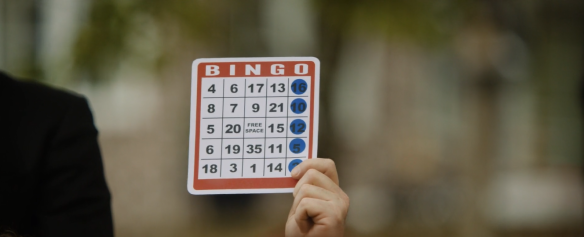 I originally interpreted his hand signals as a kind of picture voodoo, casting a spell on Chris by way of a picture, and while it does not seem that it turns out that way, it is also kind of true that that is what he is doing, because basically the joke is that where he and Chris discussed race, and he professed his liberality, he is in his cult space, one of the cult space of his sacred cult property, conducting a slave auction, for white people who want to harvest body parts of the pictured party to live forever
I originally interpreted his hand signals as a kind of picture voodoo, casting a spell on Chris by way of a picture, and while it does not seem that it turns out that way, it is also kind of true that that is what he is doing, because basically the joke is that where he and Chris discussed race, and he professed his liberality, he is in his cult space, one of the cult space of his sacred cult property, conducting a slave auction, for white people who want to harvest body parts of the pictured party to live forever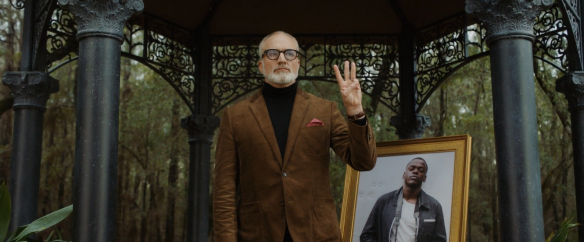 as they continue to try to leave, and she continues to try to devise ways to make him not leave, perhaps by bringing things to a crisis level where he will make a wrong move, he discovers, behind a door too conveniently left open, her box of old pictures of old romances, and is shocked to discover that not only did this whore sleep with like a gazillion guys but all of them were black, and none of the relationships lasted that long, and what the hell is going on here (his friend thinking it is a sex slave thing, and he is not far off)? This too is picture voodoo, both in the sense that she collected trophy pictures of her kills, and kept them, then that they are made available to him to see to spook him out and unnerve him into making a mistake.
as they continue to try to leave, and she continues to try to devise ways to make him not leave, perhaps by bringing things to a crisis level where he will make a wrong move, he discovers, behind a door too conveniently left open, her box of old pictures of old romances, and is shocked to discover that not only did this whore sleep with like a gazillion guys but all of them were black, and none of the relationships lasted that long, and what the hell is going on here (his friend thinking it is a sex slave thing, and he is not far off)? This too is picture voodoo, both in the sense that she collected trophy pictures of her kills, and kept them, then that they are made available to him to see to spook him out and unnerve him into making a mistake.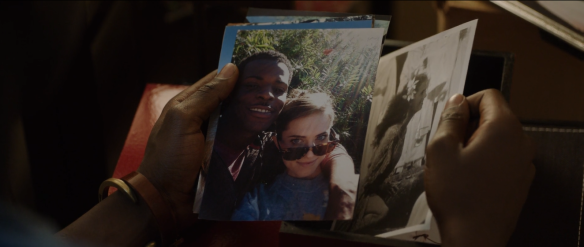 the last picture with a red bandana and a real gang banger of not too attractive looks brings her to the most low down place (and people are so weird in real life that Williams had to say in public that, no, she doesn’t identify with her character!) Now, Alison Williams is notorious for, in Girls, which made her famous, not appearing nude (though inferring it in several scenes), when everyone else was running around nude all the time. Why? It is because she is not a fightback girl, but a girl who has lived on a pedestal her whole life and whose physical being comes so close to racial perfection in terms of the classic Anglo Upper class girl of Princess Culture adulation, that to see her body requires a ticket, and pay off, she is not just going to drop her top for anyone. And certainly it is a disapointment to those who wished this movie to be a bit more of an actual horror movie, rather than a horror movie for nonhorror people, that there was no shower scene, but, then, she was in trouble, so for that to have happened the genders would have had to be switched, for the take home donor to be female, as it more common, and, in my view, makes better horror, so all we get of her physically is her tights and the fact that Williams has increddible what is known as thigh gap, that is, the open space between the legs. What this means to men is that just as a landing strip is slang for some hair that helps land the penis in intercourse, a thigh gap also promises easy access. But, at the same time, it is quite possible that too much thigh gap causes the legs to revert to being perceived as pincers, or blades, emitting a tweak of vagina dentata meaning. And it is certainly certain to me that not one second after Chris has seen his girl ex-ing with a bandana with a gangbanger, and all her boyfriends black, like she is some damn Kardashian, and then we see her in a what are you doing? posture of challenge, and the space between her legs is spread very, very wide, she is set in place, and this shot says, sorry, this is what it says, shit, she is a c–t, she is a real hard-core c–t
the last picture with a red bandana and a real gang banger of not too attractive looks brings her to the most low down place (and people are so weird in real life that Williams had to say in public that, no, she doesn’t identify with her character!) Now, Alison Williams is notorious for, in Girls, which made her famous, not appearing nude (though inferring it in several scenes), when everyone else was running around nude all the time. Why? It is because she is not a fightback girl, but a girl who has lived on a pedestal her whole life and whose physical being comes so close to racial perfection in terms of the classic Anglo Upper class girl of Princess Culture adulation, that to see her body requires a ticket, and pay off, she is not just going to drop her top for anyone. And certainly it is a disapointment to those who wished this movie to be a bit more of an actual horror movie, rather than a horror movie for nonhorror people, that there was no shower scene, but, then, she was in trouble, so for that to have happened the genders would have had to be switched, for the take home donor to be female, as it more common, and, in my view, makes better horror, so all we get of her physically is her tights and the fact that Williams has increddible what is known as thigh gap, that is, the open space between the legs. What this means to men is that just as a landing strip is slang for some hair that helps land the penis in intercourse, a thigh gap also promises easy access. But, at the same time, it is quite possible that too much thigh gap causes the legs to revert to being perceived as pincers, or blades, emitting a tweak of vagina dentata meaning. And it is certainly certain to me that not one second after Chris has seen his girl ex-ing with a bandana with a gangbanger, and all her boyfriends black, like she is some damn Kardashian, and then we see her in a what are you doing? posture of challenge, and the space between her legs is spread very, very wide, she is set in place, and this shot says, sorry, this is what it says, shit, she is a c–t, she is a real hard-core c–t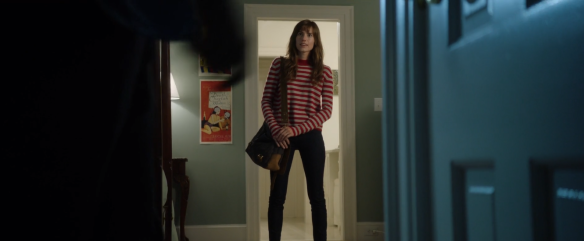 then back inside his backed up wtf head his inner screamer saying, she is REAL c–t, is figured out visually by the vagina dentata snatch form of the old fashioned Georgian bureau (lots of this in the hosue, evoking prisonhood)
then back inside his backed up wtf head his inner screamer saying, she is REAL c–t, is figured out visually by the vagina dentata snatch form of the old fashioned Georgian bureau (lots of this in the hosue, evoking prisonhood)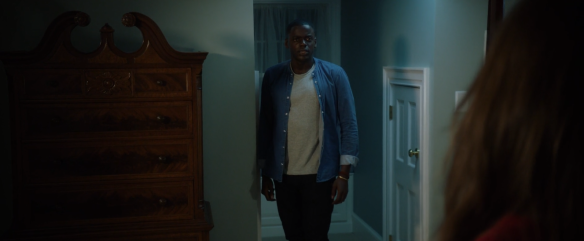 and again mirrors, again, dissembling, she is faking
and again mirrors, again, dissembling, she is faking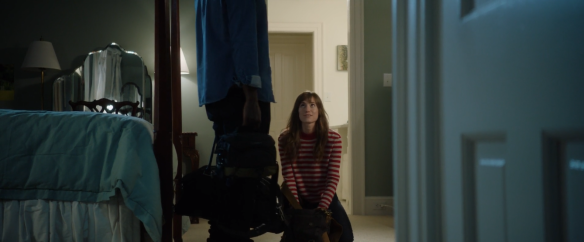 and as she sashays out of the room, her generally ersatz punk pictures, one screams about fashionista pigs
and as she sashays out of the room, her generally ersatz punk pictures, one screams about fashionista pigs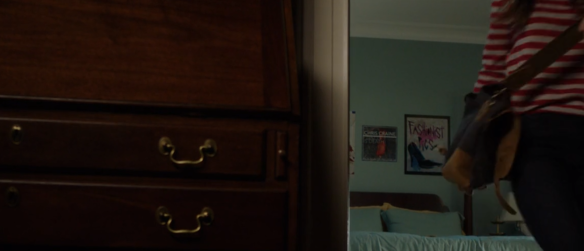 as he descends the stair, we get a better look at the black picture, it is a cliff, like at an Italian lake. I suppose it is too much to expect that it is visually related to the hilltop houses in the Giorgione picture in the dining room, but it does have visual similarity, and usually these pictures refer to Lake Nemi and places like that, so there is, at least for me, a vibe of the Golden Bough, and a rite of fight for human sacrifice
as he descends the stair, we get a better look at the black picture, it is a cliff, like at an Italian lake. I suppose it is too much to expect that it is visually related to the hilltop houses in the Giorgione picture in the dining room, but it does have visual similarity, and usually these pictures refer to Lake Nemi and places like that, so there is, at least for me, a vibe of the Golden Bough, and a rite of fight for human sacrifice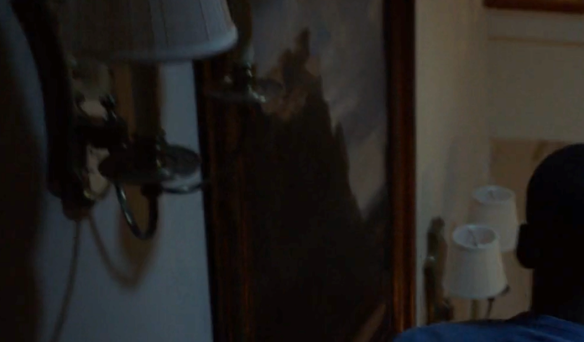 this John Robert Cozzens is the type of thing I am thinking about, this is a house on a cliff where sacrifical things happen, transposed to the suburbs
this John Robert Cozzens is the type of thing I am thinking about, this is a house on a cliff where sacrifical things happen, transposed to the suburbs In this confrontation he is entirely encircled by the closing circle of the cult, the patriarch
In this confrontation he is entirely encircled by the closing circle of the cult, the patriarch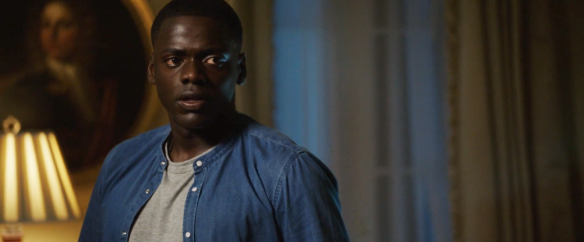 the current cult leader presiding preacherly over the mantel, under another painting of a scene
the current cult leader presiding preacherly over the mantel, under another painting of a scene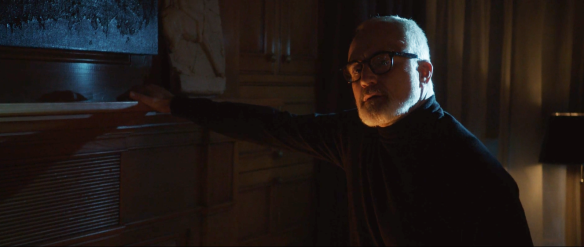 the blue boy, but reversed
the blue boy, but reversed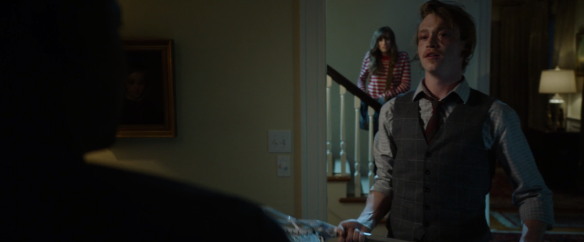 and, then, from this spin, the movie’s worst twist, and betrayal, hers, she has delivered him, like the little girl in The Wicker Man(1973), to his sacrifice, and now he is trapped, same plot, same situation, same result
and, then, from this spin, the movie’s worst twist, and betrayal, hers, she has delivered him, like the little girl in The Wicker Man(1973), to his sacrifice, and now he is trapped, same plot, same situation, same result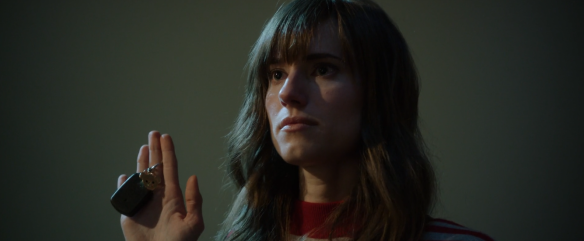 Thus, pictures have signalled the entire way, like breadcrumbs set out before the viewer, that this is a cult, it was created by the grandfather in the modern era, a bitter Olympian loser who found solace in eugenics theory and a rationale to attack the race of the man who beat him, Jesse Owens, to then prey, in their established modus operandi, on black people, to harvest body parts, in a ritual meeting of human sacrifice held each May 26, just like The Wicker Man, to meet and greet, then auction off the chosen donor subject, and then abduct and hypnotize, bind and commit transfer surgery on him, in an operation that will help the highest bidder at the slave auction recoup losses due to falling body parts to hopefully become eternal. In Part 2 of this note, I will detail the pictorial devices made use of to depict the actual ritual event in the medical underworld of this classic plantation home.
Thus, pictures have signalled the entire way, like breadcrumbs set out before the viewer, that this is a cult, it was created by the grandfather in the modern era, a bitter Olympian loser who found solace in eugenics theory and a rationale to attack the race of the man who beat him, Jesse Owens, to then prey, in their established modus operandi, on black people, to harvest body parts, in a ritual meeting of human sacrifice held each May 26, just like The Wicker Man, to meet and greet, then auction off the chosen donor subject, and then abduct and hypnotize, bind and commit transfer surgery on him, in an operation that will help the highest bidder at the slave auction recoup losses due to falling body parts to hopefully become eternal. In Part 2 of this note, I will detail the pictorial devices made use of to depict the actual ritual event in the medical underworld of this classic plantation home.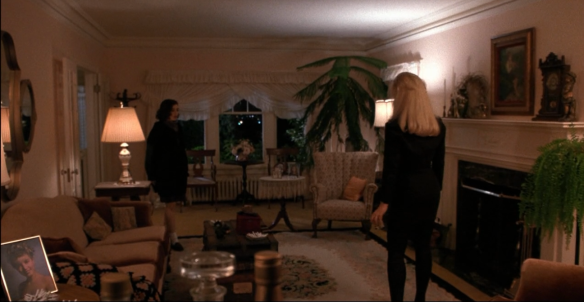 the amazingly weird thing about this shot is that apart from the unavoidably funereal cast cast over the picture, in the far left hand corner, there is one of the largest houseplants in movies ever in the front of the room, signifying fear of an intruder, and then there are even standing ferns either side of the hearth itself, which also indicates that this is a house under siege by some seriously dysfunctional problems. Though the picture over the mantel is of a young girl, and of a Victorian cast, and therefore would qualify genearlly as a Blue Boy picture (Pinkie for girls) or a Mary Shelley Picture, both of which indicate trouble coming to the female in the house or in the shot, it does not seem that that picture is made much use of, since other pictures most certainly are made much of.
the amazingly weird thing about this shot is that apart from the unavoidably funereal cast cast over the picture, in the far left hand corner, there is one of the largest houseplants in movies ever in the front of the room, signifying fear of an intruder, and then there are even standing ferns either side of the hearth itself, which also indicates that this is a house under siege by some seriously dysfunctional problems. Though the picture over the mantel is of a young girl, and of a Victorian cast, and therefore would qualify genearlly as a Blue Boy picture (Pinkie for girls) or a Mary Shelley Picture, both of which indicate trouble coming to the female in the house or in the shot, it does not seem that that picture is made much use of, since other pictures most certainly are made much of.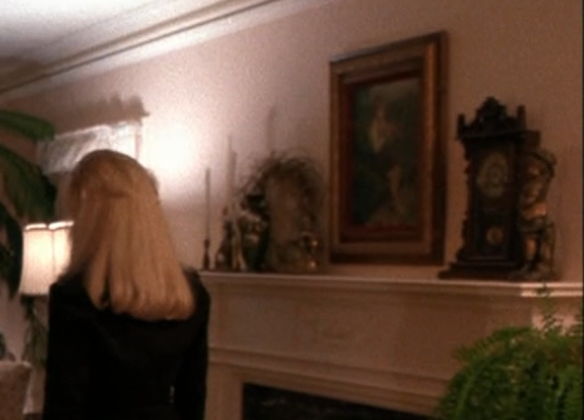 in one sequence, Laura comes in on her mother, smoking, and sulking, and doing nothing, being depressed, in that room, but then more scenes take place at the dinner table in the dining room, anad there, too, we see a particular trope in terms of the wall hangings, depleted generic floral paintings, indicating lack of life or energy in the house
in one sequence, Laura comes in on her mother, smoking, and sulking, and doing nothing, being depressed, in that room, but then more scenes take place at the dinner table in the dining room, anad there, too, we see a particular trope in terms of the wall hangings, depleted generic floral paintings, indicating lack of life or energy in the house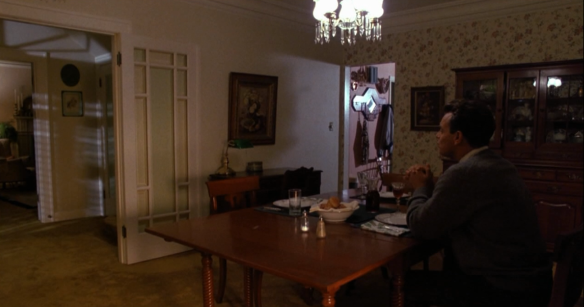 that some of the strange byplay that happens between Laura and her dad happen in between the pictures, one of them profiling Laura, indicates that something is very, very wrong in their relationship, she feels it, he feels it, it is hot and cold, depleted
that some of the strange byplay that happens between Laura and her dad happen in between the pictures, one of them profiling Laura, indicates that something is very, very wrong in their relationship, she feels it, he feels it, it is hot and cold, depleted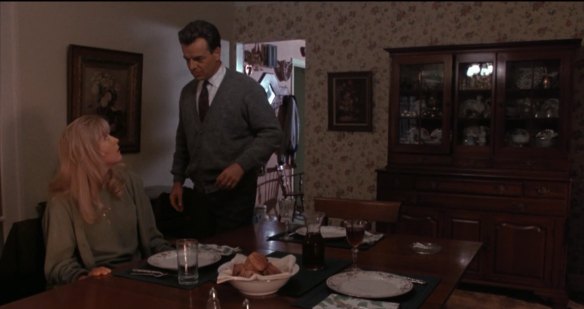 then when earlier she comes in the door, there are other depleted, Victorian style wall hangings there too
then when earlier she comes in the door, there are other depleted, Victorian style wall hangings there too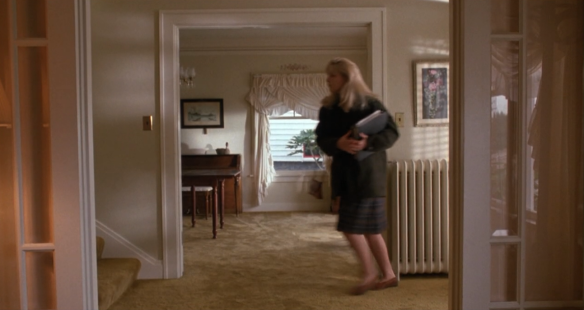 and a large floral painting at the top of the stairs, the bannister, as per trope, signifying her domestic prison, but, added onto by this, indicating death and lack of energy in the house
and a large floral painting at the top of the stairs, the bannister, as per trope, signifying her domestic prison, but, added onto by this, indicating death and lack of energy in the house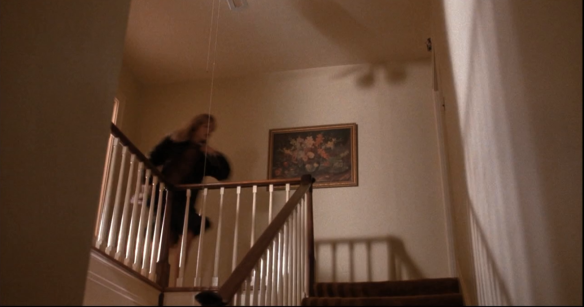 and, then, finally, and, really, almost unbelievably, there is still another depleted floral painting, also indicating lack of life, in her bedroom, over her dresser in her bedroom, almost unheard of
and, then, finally, and, really, almost unbelievably, there is still another depleted floral painting, also indicating lack of life, in her bedroom, over her dresser in her bedroom, almost unheard of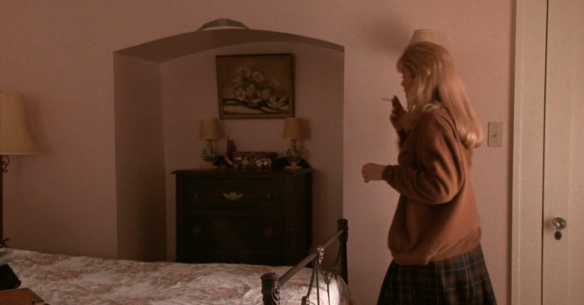 I recently wrote about the persistent use of these kinds of floral-only throws of color and flower into a house and if overdone to the point that that is the only kind of picture in the house the ensemble as a whole reduces the energy in the house to such an extent that it allows death to come in upon life, and deplete the whole space into a palliative space, closer to death than to life. This same set up was to be found in The Boogens (1981), and then, fastforwarding to today, The Lobster (2015), in each case, a house that would struggle with its grip on life, and was sliding into death, was depicted on screen as being hung throughout at at turns and corridors with pictures of the same sort. This kind of visual flooding of a setting (with a hint of the entoptic light dream state) signals to us that we are dealing with a young woman who is not just living her life, like in a teen movie, but a girl who is living, we know, the last week of her life, and, as it were, has one foot in the grave. So, right away, everything about this house, which has entirely suppressed the energy of a healthy young teenage girl, suggests serious trouble in her life.
I recently wrote about the persistent use of these kinds of floral-only throws of color and flower into a house and if overdone to the point that that is the only kind of picture in the house the ensemble as a whole reduces the energy in the house to such an extent that it allows death to come in upon life, and deplete the whole space into a palliative space, closer to death than to life. This same set up was to be found in The Boogens (1981), and then, fastforwarding to today, The Lobster (2015), in each case, a house that would struggle with its grip on life, and was sliding into death, was depicted on screen as being hung throughout at at turns and corridors with pictures of the same sort. This kind of visual flooding of a setting (with a hint of the entoptic light dream state) signals to us that we are dealing with a young woman who is not just living her life, like in a teen movie, but a girl who is living, we know, the last week of her life, and, as it were, has one foot in the grave. So, right away, everything about this house, which has entirely suppressed the energy of a healthy young teenage girl, suggests serious trouble in her life.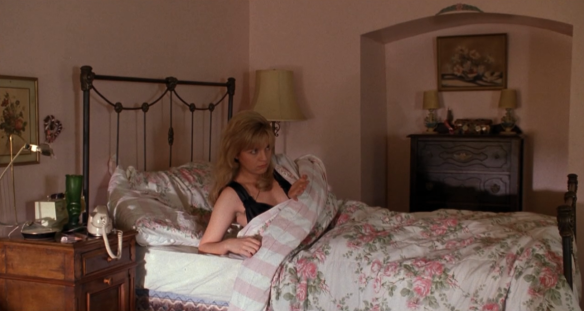 it is behind that dresser that she hides her diary, from which a page was ripped, and it is behind that dresser that we see the first appearance of her haunting by BOB, who, generally, represents her evil doppelganger, the evil Laura inside the good Laura, tormenting the good Laura, she screams, wondering who moved that dresser to read my diary and tear a page out
it is behind that dresser that she hides her diary, from which a page was ripped, and it is behind that dresser that we see the first appearance of her haunting by BOB, who, generally, represents her evil doppelganger, the evil Laura inside the good Laura, tormenting the good Laura, she screams, wondering who moved that dresser to read my diary and tear a page out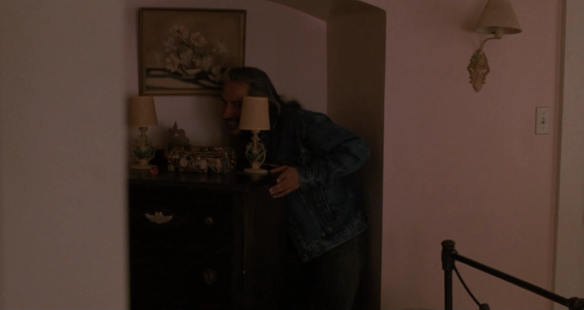 it is also in front of that picture that she hangs out on her bed, getting more and more stoned, and in the mood, by herself. We have already, by this point, seen her nude a few times, and know she does drugs, and works as a prostitute, but, somehow, seeing her indulge in her bad side in the scene of her life of her good side is more upsetting, or a sign that she is losing control and heading down, and I think that fact is conveyed by the fact that while in this shot the depleted floral picture is lit up by double lamps her backside is, with its high-cut 80s style panties, entirely exposed, she has surrendered to her dark side (so to speak)
it is also in front of that picture that she hangs out on her bed, getting more and more stoned, and in the mood, by herself. We have already, by this point, seen her nude a few times, and know she does drugs, and works as a prostitute, but, somehow, seeing her indulge in her bad side in the scene of her life of her good side is more upsetting, or a sign that she is losing control and heading down, and I think that fact is conveyed by the fact that while in this shot the depleted floral picture is lit up by double lamps her backside is, with its high-cut 80s style panties, entirely exposed, she has surrendered to her dark side (so to speak)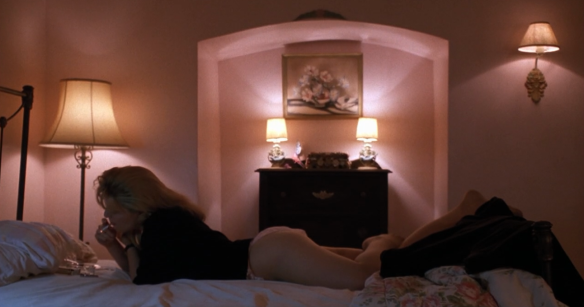 and then she gets a call from James and rather than say, as a person still in some control might say, Im not into it tonight, she says, see you in fifteen minutes, and, then, lying down, dresses, it is a lot of exposure
and then she gets a call from James and rather than say, as a person still in some control might say, Im not into it tonight, she says, see you in fifteen minutes, and, then, lying down, dresses, it is a lot of exposure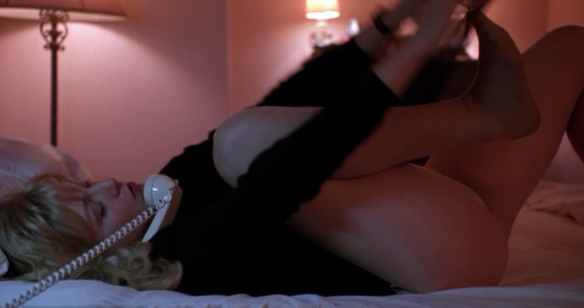 but then she does so in a way that results in her pivoting toward the camera to expose of much of pelvic area as will be shown in the movie, a kind of shot that equates her debased sex with the depleted nature of the floral picture, and indicating that she has gone down the drain
but then she does so in a way that results in her pivoting toward the camera to expose of much of pelvic area as will be shown in the movie, a kind of shot that equates her debased sex with the depleted nature of the floral picture, and indicating that she has gone down the drain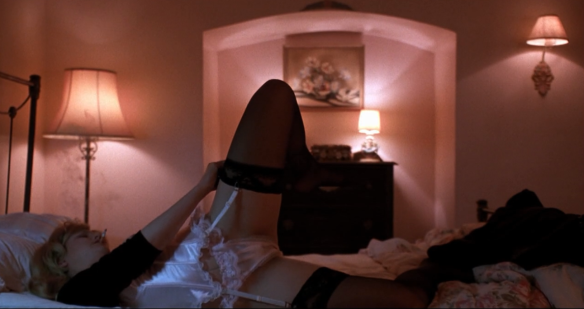 (It could be argued that this represents another incidental example of the 80s horror movie trope of the power crotch, as seen, for example, in Blood Harvest, but my ruling is no, it does not seem to indicate that, it appears to go back to a predated trope whereby exposure of crotch on camera meant she is a dead girl, here equated, in fact, with the floral painting).
(It could be argued that this represents another incidental example of the 80s horror movie trope of the power crotch, as seen, for example, in Blood Harvest, but my ruling is no, it does not seem to indicate that, it appears to go back to a predated trope whereby exposure of crotch on camera meant she is a dead girl, here equated, in fact, with the floral painting).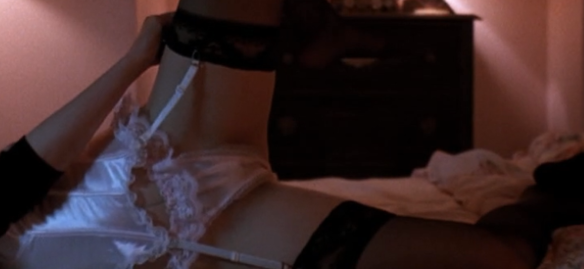 it could of course be said that on a deeper, rougher, level the floral bouqet painting of an ersatz sort represents the female sexual organ, and so this one makes the connection literal by lining up her private area arrayed in lingerie with the bouquet, the shot in effect, for her devaluing of her sex, calling her a whore or a c—nt, with her talking and smoking and not caring about anything during it. And then she runs off, so, this particular painting means something. It acts as a self-reflecting mirror that bespeaks the state of unhappiness she is in for having wasted her life energy in a depleted, degraded life. That is, a picture works well, with clear evidence of picture play to, by profiling Laura, bespeak her predicament in her home life.
it could of course be said that on a deeper, rougher, level the floral bouqet painting of an ersatz sort represents the female sexual organ, and so this one makes the connection literal by lining up her private area arrayed in lingerie with the bouquet, the shot in effect, for her devaluing of her sex, calling her a whore or a c—nt, with her talking and smoking and not caring about anything during it. And then she runs off, so, this particular painting means something. It acts as a self-reflecting mirror that bespeaks the state of unhappiness she is in for having wasted her life energy in a depleted, degraded life. That is, a picture works well, with clear evidence of picture play to, by profiling Laura, bespeak her predicament in her home life.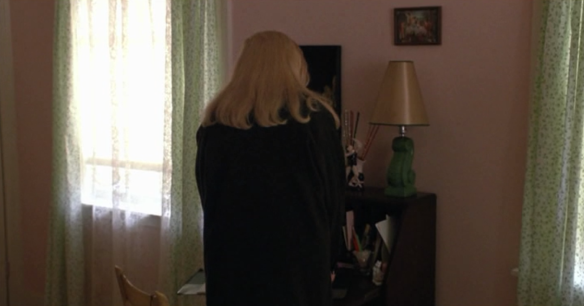 twice this picture is given full screen treatment as the receiver of Laura’s imaginings. It obviously means something to her, maybe she carried it out of her childhood and her Sunday school lessons to bring it on as a totem of who she is into her teenage life. She seems to address it in a way that prays to it, to make it come alive. It is a guardian picture, her apotropaic picture, where to she directs her prayers to her guardian angel, asking it for help
twice this picture is given full screen treatment as the receiver of Laura’s imaginings. It obviously means something to her, maybe she carried it out of her childhood and her Sunday school lessons to bring it on as a totem of who she is into her teenage life. She seems to address it in a way that prays to it, to make it come alive. It is a guardian picture, her apotropaic picture, where to she directs her prayers to her guardian angel, asking it for help and the movie makes no bones about this fact, indeed, in this sequence, she stares close up at it, and fixates on the wings of the angel, as if to say, wrap me in your wings, help me, save me
and the movie makes no bones about this fact, indeed, in this sequence, she stares close up at it, and fixates on the wings of the angel, as if to say, wrap me in your wings, help me, save me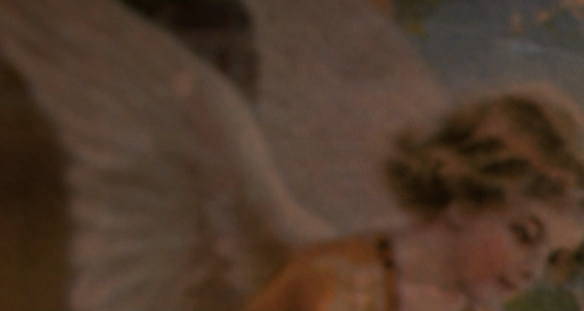 then, back to the scene where she is getting dressed in a very revealing way to go out with James, but then ends up with Jacques and Leo at the Black Lodge, she looks at the picture again, with a bit more trepidation. It is lit from the lamp from below, which, as with the making of scary faces, or with the placement of persons above a lamp in that way, means that it has been cast outside of her intimacy, and it is threatened
then, back to the scene where she is getting dressed in a very revealing way to go out with James, but then ends up with Jacques and Leo at the Black Lodge, she looks at the picture again, with a bit more trepidation. It is lit from the lamp from below, which, as with the making of scary faces, or with the placement of persons above a lamp in that way, means that it has been cast outside of her intimacy, and it is threatened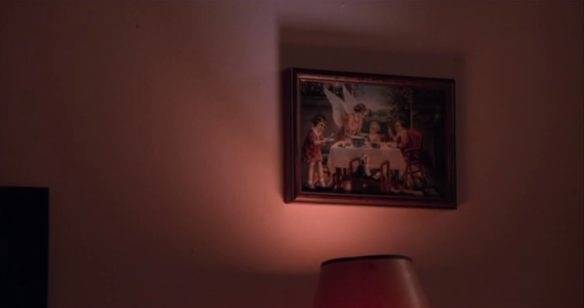 and then when she fixates on it and looks at it again as if to seek from it a prognosis of how the evening is going to go she is upset that the angel seems to disappear, and the movie therefore not only instrumentalizes the picture, but turns it into a vision picture which in its alteration predicts a plot point
and then when she fixates on it and looks at it again as if to seek from it a prognosis of how the evening is going to go she is upset that the angel seems to disappear, and the movie therefore not only instrumentalizes the picture, but turns it into a vision picture which in its alteration predicts a plot point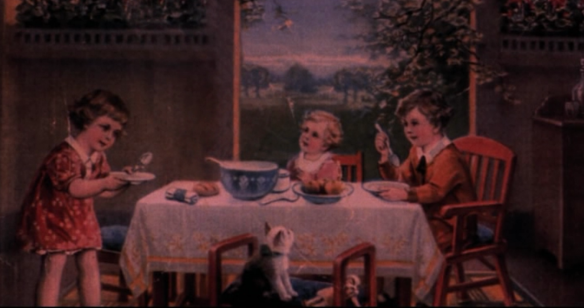 the weird thing about the disappearance of the angel is that the angel shows up later as a representative, in the spirit world, of the soul of Laura, as she seeks a resting place in other place. We see the angel in the red room at the end of the other place
the weird thing about the disappearance of the angel is that the angel shows up later as a representative, in the spirit world, of the soul of Laura, as she seeks a resting place in other place. We see the angel in the red room at the end of the other place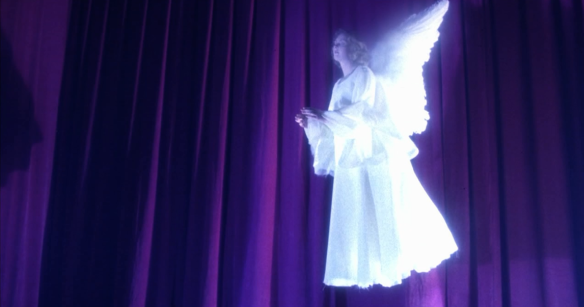 and it is suddenly superimposed upon by the angel
and it is suddenly superimposed upon by the angel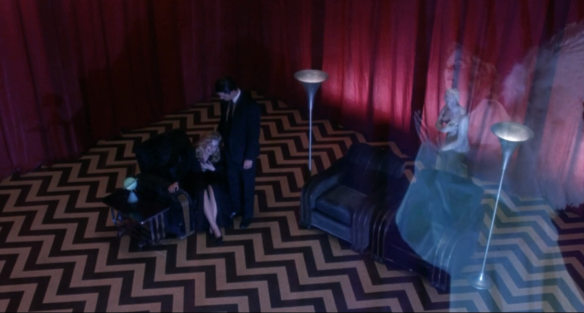 the idea that her struggle is over, and that in the other place she will be watched over by the angel, and by Cooper, seems to make her feel better, she ends the movie smiling. Also, the fact that by superimposition the angel has overridden the power of the Venus Knidos as the symbol of her exploited physical being, means that she has by the angel been transformed into a spirit in the other place, not apparently to suffer, for most of the crimes committed against her were not of her doing, really. The use of the Venus as a cult statue at the farthest prototype space behind the inhabitation of the dark zone by the figures of the other place is a strange development. It makes the whole movie about a girl who was part of the cult of love, but full of persons who could only get to it by conflicted, illegal ways, or others who lost their path on the way. The man from another place sits before it like the priest of the love cult, the boss at some nightclub in the afterlife, the statue itself is entirely ersatz, and it is approached by a primrose path lined by those depleted floral paintings, it is the goddess of love that Laura worships, but she loses herself on the way. Still, it interesting that Lynch brings pagan mythology and love cult into it as one other place in the movie a goddess from the pagan shows up in her descent into the red zone and the red room. At one point, in the club, all of it lit red to allow for a certainly veil of privacy even in public acts, she has no trouble pleasing the customer and accompanying them in debauchery by taking her top off, and dancing half naked from the waist up
the idea that her struggle is over, and that in the other place she will be watched over by the angel, and by Cooper, seems to make her feel better, she ends the movie smiling. Also, the fact that by superimposition the angel has overridden the power of the Venus Knidos as the symbol of her exploited physical being, means that she has by the angel been transformed into a spirit in the other place, not apparently to suffer, for most of the crimes committed against her were not of her doing, really. The use of the Venus as a cult statue at the farthest prototype space behind the inhabitation of the dark zone by the figures of the other place is a strange development. It makes the whole movie about a girl who was part of the cult of love, but full of persons who could only get to it by conflicted, illegal ways, or others who lost their path on the way. The man from another place sits before it like the priest of the love cult, the boss at some nightclub in the afterlife, the statue itself is entirely ersatz, and it is approached by a primrose path lined by those depleted floral paintings, it is the goddess of love that Laura worships, but she loses herself on the way. Still, it interesting that Lynch brings pagan mythology and love cult into it as one other place in the movie a goddess from the pagan shows up in her descent into the red zone and the red room. At one point, in the club, all of it lit red to allow for a certainly veil of privacy even in public acts, she has no trouble pleasing the customer and accompanying them in debauchery by taking her top off, and dancing half naked from the waist up then she and her partner in crime continue on living the night in debauchery at the club, and Laura has her top off, so it will stay off, it is her costume now, it is how she is conducting the evening. But at this point the man has gone under the booth table and is performing oral sex on her, but just then she looks across the entoptic space and sees her friend trying to keep up with and stay with her, and maybe going further than Laura thought she would, having also removed her top, and accepted fondling and kissing by the clientele
then she and her partner in crime continue on living the night in debauchery at the club, and Laura has her top off, so it will stay off, it is her costume now, it is how she is conducting the evening. But at this point the man has gone under the booth table and is performing oral sex on her, but just then she looks across the entoptic space and sees her friend trying to keep up with and stay with her, and maybe going further than Laura thought she would, having also removed her top, and accepted fondling and kissing by the clientele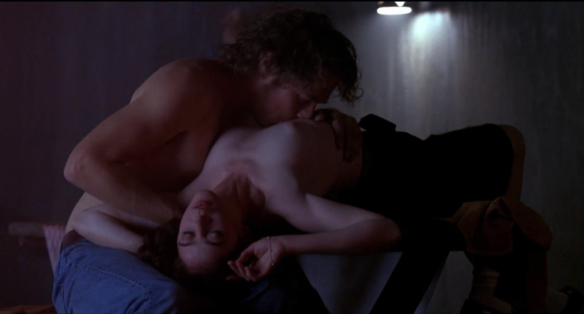 it is odd, one of those compromise formations that people develop to have something, but within the context of both social limits in the fiction of the movie, and within the limits of depiction of the movie, not unlike such formations seen in old movies. It is sex, but sex reduced to just fondling and kissing the breasts. But Laura freaks, the ostensible reason for getting upset is all about sleepover girltalk bedroom issues, her friend has stolen her dress, but the real reason is that there remains something good in her conscience that knows what she is doing it slutty and whorish and she does not want her good friend to follow her down, so she attacks. But the fun thing here is, there is a wellknown print of a famous picture behind this fight, in this movie. Of course, it is always possible that this is just circumstantial, and means nothing. But for a movie director with such a careful eye as Lynch, I think not.
it is odd, one of those compromise formations that people develop to have something, but within the context of both social limits in the fiction of the movie, and within the limits of depiction of the movie, not unlike such formations seen in old movies. It is sex, but sex reduced to just fondling and kissing the breasts. But Laura freaks, the ostensible reason for getting upset is all about sleepover girltalk bedroom issues, her friend has stolen her dress, but the real reason is that there remains something good in her conscience that knows what she is doing it slutty and whorish and she does not want her good friend to follow her down, so she attacks. But the fun thing here is, there is a wellknown print of a famous picture behind this fight, in this movie. Of course, it is always possible that this is just circumstantial, and means nothing. But for a movie director with such a careful eye as Lynch, I think not.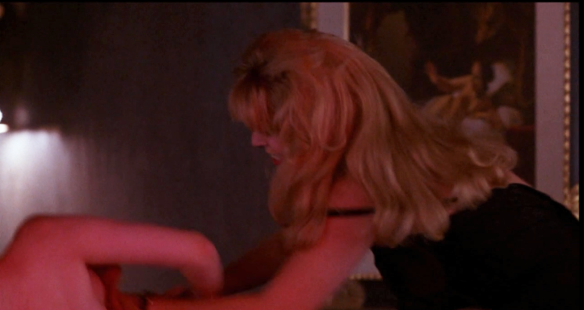 It is Rembrandt’s Danae.
It is Rembrandt’s Danae.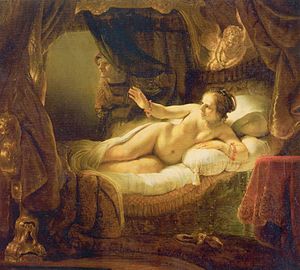
 and it is a fight, in front of the Danae
and it is a fight, in front of the Danae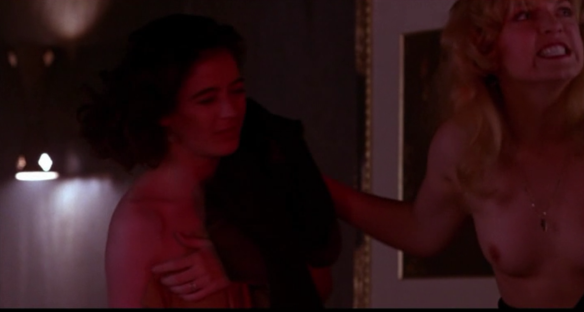 what could it mean? Danae in Greek mythology was the daughter of Akriosis, whose uncle, Akriosis’s brother, Proetus, wanted to sleep with. Akriosis and Proteus were twins, fighting for control of Agros. So, just there, the twin theme, the twin-peak theme, but then also the incest theme, in this case Laura might’ve got to be so close to her friend that she thought of her as a sister and when she began to imitate her behavior too closely, and too nudely, that cut too close to home, and she freaked. So, there is that level. But then the more well-known part of the tale is that Akriosis was told by an oracle that Danae would give birth to a child who would dethrone him, so to make sure that no man came to her, and impregnated her, put her up in a castle (or down in a pit), sequestered from sex. According to the most famous telling of the tale, Zeus got round the protection against him by turning into a shower of gold coins and impregnating her that way. There is another part of the story where she is cast off in a box at sea to wash ashore in the land of Polycletes where there her son Perseus came of age then contested the king in favor of Danae by promising and killing the medusa. In any case, Danae represents a woman sequestered against her will on behalf of her father’s needs, not hers, and then the spirits find a way to fulfill the prophecy anyways. As for the shower of gold–thankfully no actual golden showers here, this is not Moscow, 2016–it, in its odd context in a dive bar (!), could represent prostitution. But, overall, Danae represents a more conflicted goddess image presiding over Laura as she heads into deeper water in her lifestyle, leading to death. If Knidos is at the far end of the cult space, then Danae is located in a corridor en route to it, a corrupt place, where a stripping bare has occurred, but not yet at the zone of death.
what could it mean? Danae in Greek mythology was the daughter of Akriosis, whose uncle, Akriosis’s brother, Proetus, wanted to sleep with. Akriosis and Proteus were twins, fighting for control of Agros. So, just there, the twin theme, the twin-peak theme, but then also the incest theme, in this case Laura might’ve got to be so close to her friend that she thought of her as a sister and when she began to imitate her behavior too closely, and too nudely, that cut too close to home, and she freaked. So, there is that level. But then the more well-known part of the tale is that Akriosis was told by an oracle that Danae would give birth to a child who would dethrone him, so to make sure that no man came to her, and impregnated her, put her up in a castle (or down in a pit), sequestered from sex. According to the most famous telling of the tale, Zeus got round the protection against him by turning into a shower of gold coins and impregnating her that way. There is another part of the story where she is cast off in a box at sea to wash ashore in the land of Polycletes where there her son Perseus came of age then contested the king in favor of Danae by promising and killing the medusa. In any case, Danae represents a woman sequestered against her will on behalf of her father’s needs, not hers, and then the spirits find a way to fulfill the prophecy anyways. As for the shower of gold–thankfully no actual golden showers here, this is not Moscow, 2016–it, in its odd context in a dive bar (!), could represent prostitution. But, overall, Danae represents a more conflicted goddess image presiding over Laura as she heads into deeper water in her lifestyle, leading to death. If Knidos is at the far end of the cult space, then Danae is located in a corridor en route to it, a corrupt place, where a stripping bare has occurred, but not yet at the zone of death.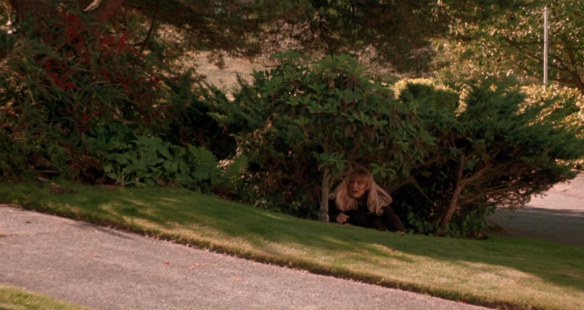 this is the evergreen (pun) crawlspaces of suburban life, the place of peepers and the like, spying in on the better domestic lives of others. It is an unhappy place, a marginal space in which one is reduced of any energy in one’s own life, so has to get life by looking in on others. Places where this trope comes up in horror are too numerous to name. But the weird thing here is that Laura doesn’t hide under it, or isn’t peeping, she is just seeking some impromptu shelter. She also has with her, and has taken with her a picture, another picture, which of all the pictures in this movie that instrumentalizes picture at three different levels of intensity, is made the most of
this is the evergreen (pun) crawlspaces of suburban life, the place of peepers and the like, spying in on the better domestic lives of others. It is an unhappy place, a marginal space in which one is reduced of any energy in one’s own life, so has to get life by looking in on others. Places where this trope comes up in horror are too numerous to name. But the weird thing here is that Laura doesn’t hide under it, or isn’t peeping, she is just seeking some impromptu shelter. She also has with her, and has taken with her a picture, another picture, which of all the pictures in this movie that instrumentalizes picture at three different levels of intensity, is made the most of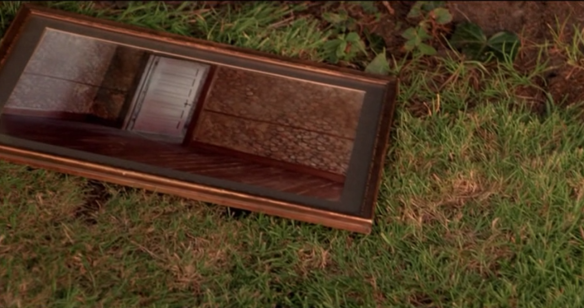 it is a very strange picture. Whoever receives a picture like that of an empty room? no one, never happens. How many pictures of that sort are there? very few. It is a mystery, and, as that, a dream picture. She first got it when she talking to Shelly coming out of the diner, and two more odd figures hand it to her
it is a very strange picture. Whoever receives a picture like that of an empty room? no one, never happens. How many pictures of that sort are there? very few. It is a mystery, and, as that, a dream picture. She first got it when she talking to Shelly coming out of the diner, and two more odd figures hand it to her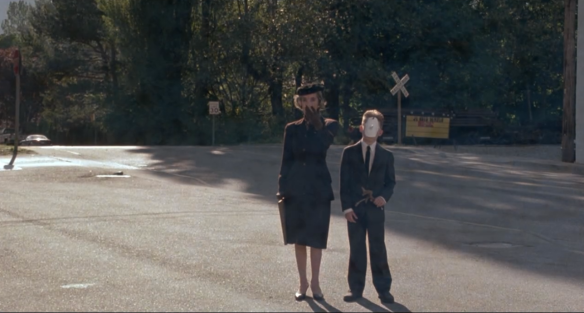 it is possible that these characters have identities in the wiki of the thing, maybe they are her grandmother, and her father as a young boy, warning her of his teenage boy lusts, but what they do here is call her away from Shelley and delivering Meals on Wheels to old people, to be handed a picture, weird
it is possible that these characters have identities in the wiki of the thing, maybe they are her grandmother, and her father as a young boy, warning her of his teenage boy lusts, but what they do here is call her away from Shelley and delivering Meals on Wheels to old people, to be handed a picture, weird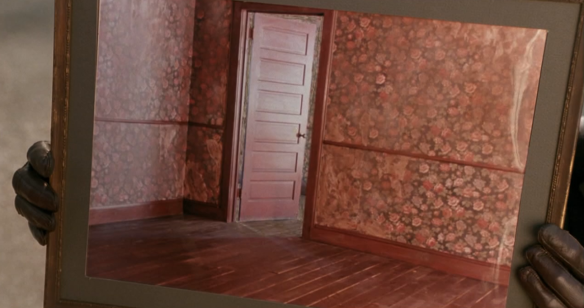 one of the tropes of the quest theme is to be given magic tools by persons along the way, who will help you get to where you need to. Here, it is a waking figure, telling her a secret, giving a clue of where she needs to go to find out what the answer to her problem is. Like the angels that appear to Joseph, then, this is a warning angel, and a doorman, as it were, to lead her in. Who the little boy is, and what he does, is less clear, though later he also shows up to close down the scene of dad and Laura being crazy in the parking lot. At present, since the picture represents a concentrated image of a place, and has more or less the structure for it, this is a lattice image, the image that will pool the issue and draw it down into a concentrated swirl, so she is the figure that stands at the top of the lattice, pointing the way, an usher. That Laura then thought enough of it and that it might be important in helping her fight off BOB is indicated by the fact that when she ran out of the house, she took the picture with her. But, then, she hangs the picture up. That is, there have been florals, there is the Guardian Angel picture, pictures that merely bespeak palliative space, another picture that acts as an apotropaic guardian augur as it were to tell her how to behave, and now a third degree of picture, put up at the end of her bed, across the room.
one of the tropes of the quest theme is to be given magic tools by persons along the way, who will help you get to where you need to. Here, it is a waking figure, telling her a secret, giving a clue of where she needs to go to find out what the answer to her problem is. Like the angels that appear to Joseph, then, this is a warning angel, and a doorman, as it were, to lead her in. Who the little boy is, and what he does, is less clear, though later he also shows up to close down the scene of dad and Laura being crazy in the parking lot. At present, since the picture represents a concentrated image of a place, and has more or less the structure for it, this is a lattice image, the image that will pool the issue and draw it down into a concentrated swirl, so she is the figure that stands at the top of the lattice, pointing the way, an usher. That Laura then thought enough of it and that it might be important in helping her fight off BOB is indicated by the fact that when she ran out of the house, she took the picture with her. But, then, she hangs the picture up. That is, there have been florals, there is the Guardian Angel picture, pictures that merely bespeak palliative space, another picture that acts as an apotropaic guardian augur as it were to tell her how to behave, and now a third degree of picture, put up at the end of her bed, across the room.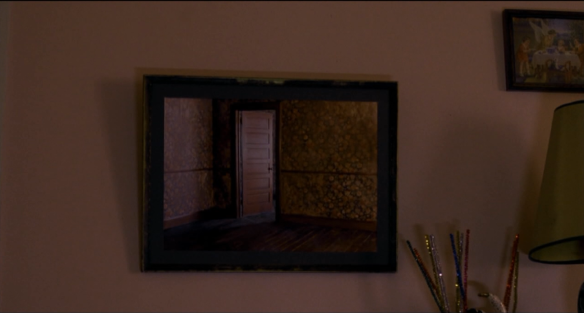 and then Lynch instrumentalizes it. Laura can’t sleep, or is in an entoptic stage of sleepiness, and gazes over at it
and then Lynch instrumentalizes it. Laura can’t sleep, or is in an entoptic stage of sleepiness, and gazes over at it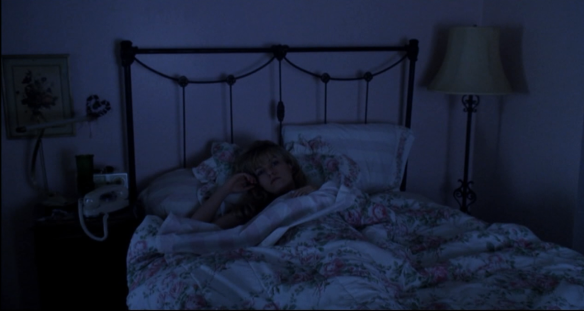 because of the low light in the room, and the lightning or moonlight, the glare off the door in the picture now all but glares out of the picture into the room, reducing the mediated wall between them
because of the low light in the room, and the lightning or moonlight, the glare off the door in the picture now all but glares out of the picture into the room, reducing the mediated wall between them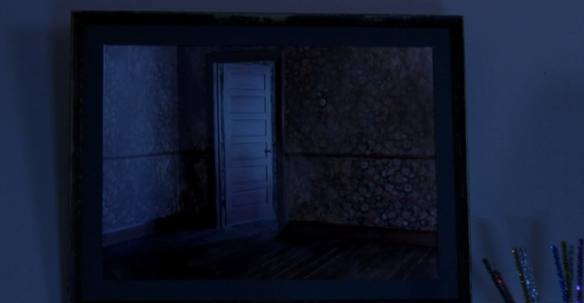 and then her mind goes into the picture, we are passing through a door
and then her mind goes into the picture, we are passing through a door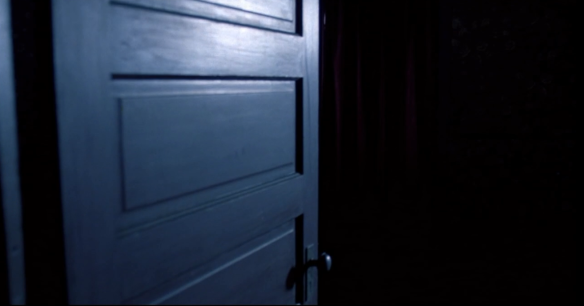 as we get into the dream state, for Laura has now nodded off to sleep, and is wandering through a maze created in the glass onion phase, she sees that usher figure again
as we get into the dream state, for Laura has now nodded off to sleep, and is wandering through a maze created in the glass onion phase, she sees that usher figure again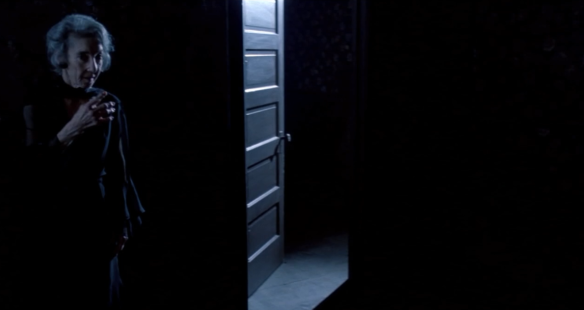 pointing the way
pointing the way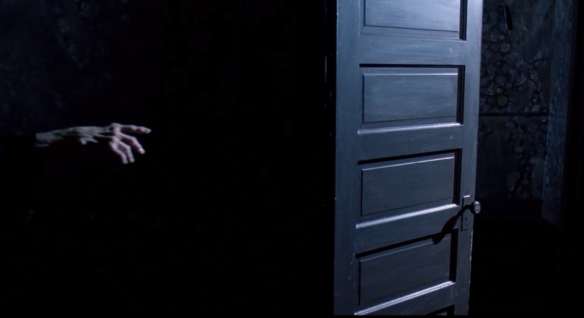 then we open into the room within or past the room, apparently wallpapered in the same way, as all spaces in that maze would be, in a glass onion style run-on dream, it is roses on black wallpaper
then we open into the room within or past the room, apparently wallpapered in the same way, as all spaces in that maze would be, in a glass onion style run-on dream, it is roses on black wallpaper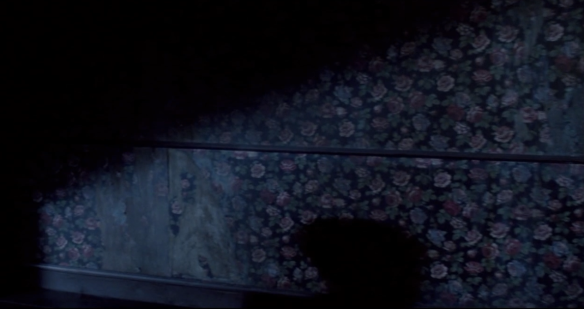 I have written of this pattern before. This pattern, specifically, refers to the nursery, and to woman’s fertility and maternal feeling. The reason that it keeps coming up generation after generation as one of the generic tropes of fashion is that it is very difficult for people in certain states of mind to not gaze on the female body and think of motherhood, or the elements of motherhood, vulva, vagina, uterus and breasts, which are here represented by the pink roses. And then the black background raises the ugly possibility that in spite of the maternal instinct in nature in the modern world the instinct can be twisted into something perverse and destructive, and therefore it acknowledges the dark mother too. This trope of design can be seen in movies in the 70s like The Witch’s Mountain (1972, Spain).
I have written of this pattern before. This pattern, specifically, refers to the nursery, and to woman’s fertility and maternal feeling. The reason that it keeps coming up generation after generation as one of the generic tropes of fashion is that it is very difficult for people in certain states of mind to not gaze on the female body and think of motherhood, or the elements of motherhood, vulva, vagina, uterus and breasts, which are here represented by the pink roses. And then the black background raises the ugly possibility that in spite of the maternal instinct in nature in the modern world the instinct can be twisted into something perverse and destructive, and therefore it acknowledges the dark mother too. This trope of design can be seen in movies in the 70s like The Witch’s Mountain (1972, Spain).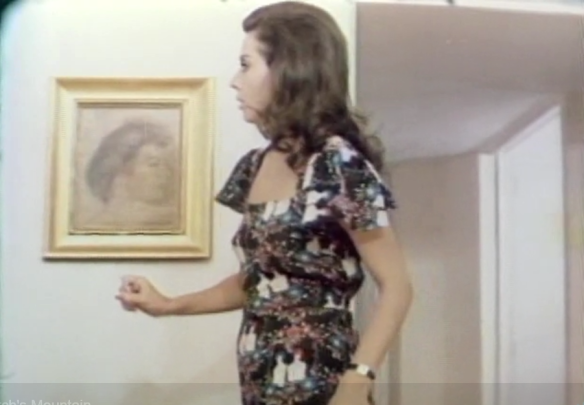 And it does seem to represent just that, conflicted motherhood, a mother doing something bad. For this woman in the above shot is there to kill an evil child. But, then, it struck me that in the early 80s this trope, having depleted for a time, suddenly gained new life from a retrograde trope formation trend in the culture which caused it to again emerge as the go-to outfit to represent the dark mother in horror, and I can offer examples from the Toolbox Murders (1981)
And it does seem to represent just that, conflicted motherhood, a mother doing something bad. For this woman in the above shot is there to kill an evil child. But, then, it struck me that in the early 80s this trope, having depleted for a time, suddenly gained new life from a retrograde trope formation trend in the culture which caused it to again emerge as the go-to outfit to represent the dark mother in horror, and I can offer examples from the Toolbox Murders (1981)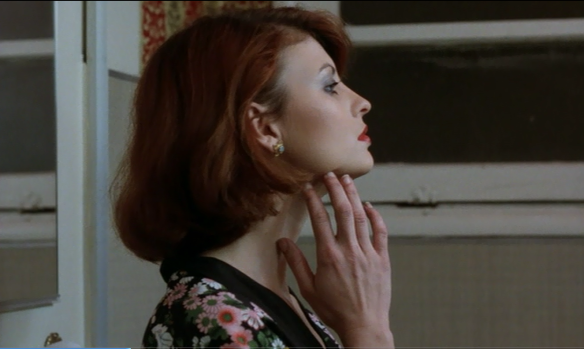 and several other examples are possible (the odd thing about this timing, which also proves its temporary status given the experience in time of a particular age group is that I began to develop a fetish for this pattern whenever I saw it on a woman, only to then realize, in a picture I still own, that I had that feeling because that was the pattern of the wallpaper in my nursery, and thus the patterns I gazed upon negatively when my mother was giving attention to my older brother). For all this, this pattern, generally, represents a darkness in the family. And, sure enough, here too, after this zigzag down a primrose path of roses on black, the boy, again I think this is her father as a boy, a lusting little animal
and several other examples are possible (the odd thing about this timing, which also proves its temporary status given the experience in time of a particular age group is that I began to develop a fetish for this pattern whenever I saw it on a woman, only to then realize, in a picture I still own, that I had that feeling because that was the pattern of the wallpaper in my nursery, and thus the patterns I gazed upon negatively when my mother was giving attention to my older brother). For all this, this pattern, generally, represents a darkness in the family. And, sure enough, here too, after this zigzag down a primrose path of roses on black, the boy, again I think this is her father as a boy, a lusting little animal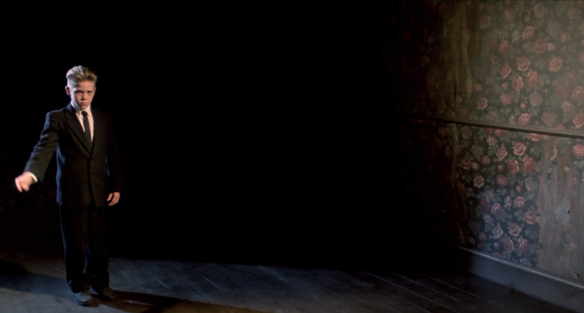 and then from that room, things proceed still further into another chamber, and there is the red room of the another place, where Cooper is, in his status as clairvoyant
and then from that room, things proceed still further into another chamber, and there is the red room of the another place, where Cooper is, in his status as clairvoyant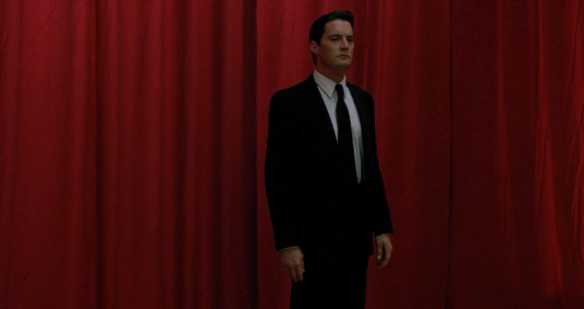 so, a picture is not just used to dissolve over, in the viewer’s eyes, as the guardian angel picture, a picture is used as an actual intercessional portal into the world of dream, which quickly concentrates on the space, and then hangs in it, and then from that leads Laura down in to the dreamstate space of the red room, for her to gain some awareness, perhaps.
so, a picture is not just used to dissolve over, in the viewer’s eyes, as the guardian angel picture, a picture is used as an actual intercessional portal into the world of dream, which quickly concentrates on the space, and then hangs in it, and then from that leads Laura down in to the dreamstate space of the red room, for her to gain some awareness, perhaps.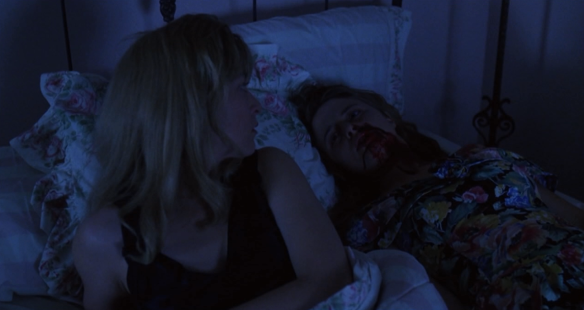 and then we see her come out
and then we see her come out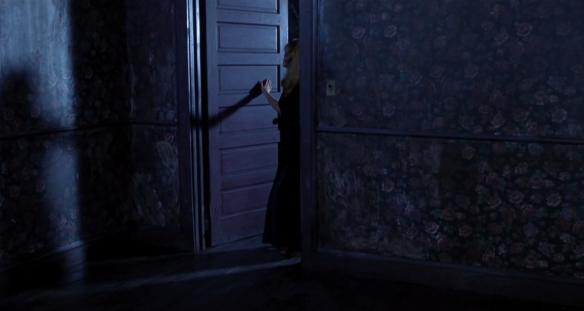 after this dream travel the two zones of space, waking and dreaming, mere more thoroughly, more deeply, she now has hypnagogic visions while waking, but there are nightmares
after this dream travel the two zones of space, waking and dreaming, mere more thoroughly, more deeply, she now has hypnagogic visions while waking, but there are nightmares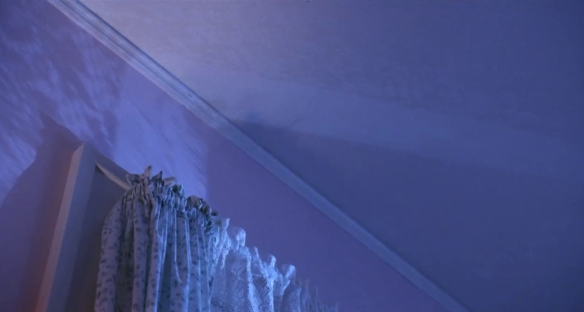 BOB even comes through her window and rapes her, she imagines
BOB even comes through her window and rapes her, she imagines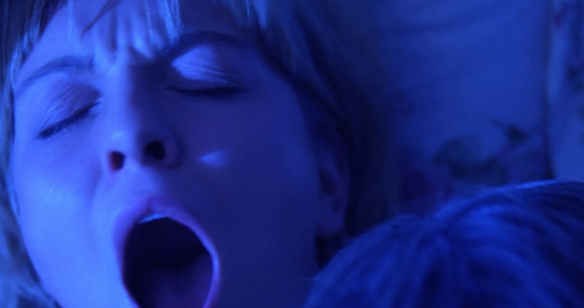 This fusing or confusing of dream and waking state now puts such pressure on the lattice, on that space, that the whole move goes whoosh down the spiral to deep dream, except for one thing, she lands in life, not dream. And that is because what has just been shown is a classic nightmare. The Greeks argued that a nightmare was brought to one by ephialtes, the leaper, and the lore of this internal response lingers in descriptions of hag attacks, and other events in sleep, apparently taking place in life. Sleep paralysis is what a state is called when the person drops down into the whoosh, or spiral, but, then, for some reason, of some dysfunction, wakes up, this causes a bounce out effect, which ends up with one tossed back into waking life, but still, technically, asleep. This seems to be the mechanics of the nightmare, the nightmare never gets to deep REM sleep, it is interrupted before it gets there, so, that, in sudden shock out of a whoosh, one thinks one is awake, but you are still sleeping. This is now what happens in Fire Walk With Me.
This fusing or confusing of dream and waking state now puts such pressure on the lattice, on that space, that the whole move goes whoosh down the spiral to deep dream, except for one thing, she lands in life, not dream. And that is because what has just been shown is a classic nightmare. The Greeks argued that a nightmare was brought to one by ephialtes, the leaper, and the lore of this internal response lingers in descriptions of hag attacks, and other events in sleep, apparently taking place in life. Sleep paralysis is what a state is called when the person drops down into the whoosh, or spiral, but, then, for some reason, of some dysfunction, wakes up, this causes a bounce out effect, which ends up with one tossed back into waking life, but still, technically, asleep. This seems to be the mechanics of the nightmare, the nightmare never gets to deep REM sleep, it is interrupted before it gets there, so, that, in sudden shock out of a whoosh, one thinks one is awake, but you are still sleeping. This is now what happens in Fire Walk With Me.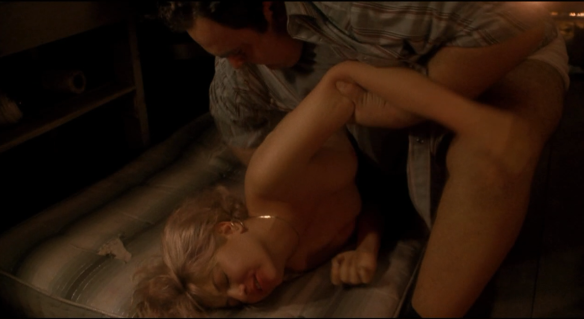 and it is down there that she cannot tell anymore the difference between the doubles, the good and the bad, life or dream, rape or nightmare, her father comes in apparently to rescue her, except it does not look like he wants to rescue her, she screams, unclear, what the hell is going on?
and it is down there that she cannot tell anymore the difference between the doubles, the good and the bad, life or dream, rape or nightmare, her father comes in apparently to rescue her, except it does not look like he wants to rescue her, she screams, unclear, what the hell is going on?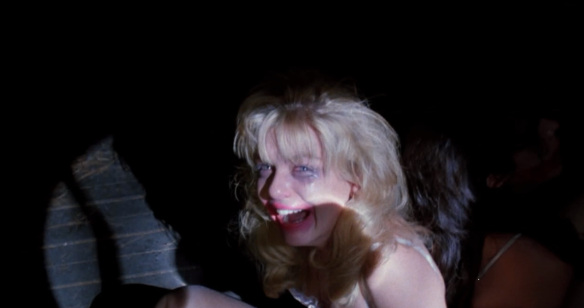 she doubles herself up in a mirror trying to see if there is any of the good her left in her, nope
she doubles herself up in a mirror trying to see if there is any of the good her left in her, nope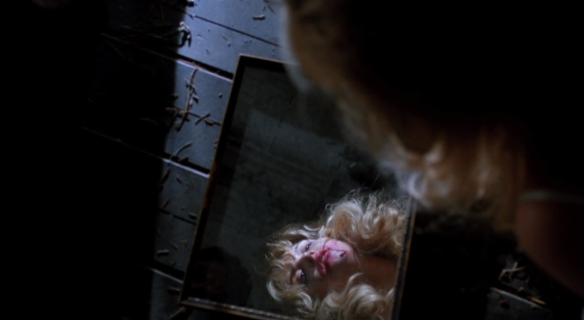 and her father can’t tell, am I here to rescue her? or am I so mad at her I want to beat her> or am I so turned on by her, and by the knowledge that she was a hooker, and that I almost got to sleep with her earlier in a setup trick, that I want to sleep with her, my own daughter? and, he too is so horrified by this final whoosh confusion of good-bad, unable to tell the difference, that his only way out is to cut the gordion knot by killing her. The killing is not entirely handled perfectly, with Lynch having to represent the bottoming out and the final fusing-confusing of the twin dimensions of twin peaks, he tries tv static, an evergreen trope for utter loss of feeling
and her father can’t tell, am I here to rescue her? or am I so mad at her I want to beat her> or am I so turned on by her, and by the knowledge that she was a hooker, and that I almost got to sleep with her earlier in a setup trick, that I want to sleep with her, my own daughter? and, he too is so horrified by this final whoosh confusion of good-bad, unable to tell the difference, that his only way out is to cut the gordion knot by killing her. The killing is not entirely handled perfectly, with Lynch having to represent the bottoming out and the final fusing-confusing of the twin dimensions of twin peaks, he tries tv static, an evergreen trope for utter loss of feeling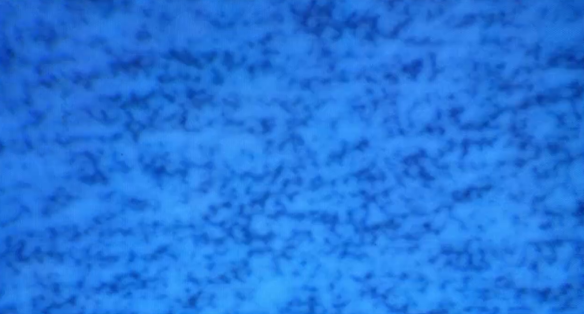 he tries the angel pressing his hands firmly together, as if the meld them into one
he tries the angel pressing his hands firmly together, as if the meld them into one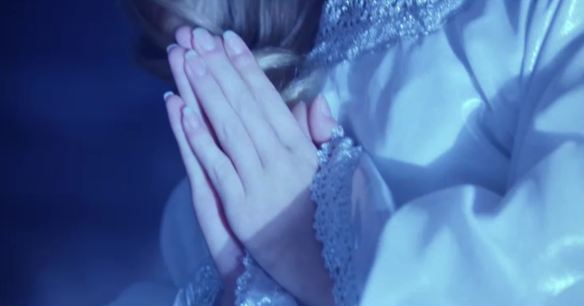 he also brings in a ring which I have ignored in this treatment, but apparently identified who was to blame and that’s how Laura dies.
he also brings in a ring which I have ignored in this treatment, but apparently identified who was to blame and that’s how Laura dies.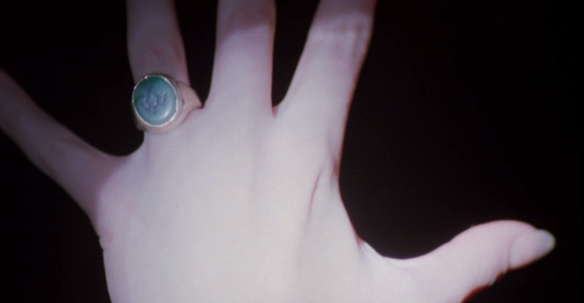 Now, I have elsewhere argued that Lynch has a primarily pagan sense of dream space, and that his dream space is a nuanced zig-zag mapping out of spirit space in and around human beings living in a particular psychogeography with its psychological profile of doppelganging like Twin Peaks. I also have noted that in Roman sarcophagal art in particular after the Romans got to the rock bottom of dream space, REM deep dream, they seem to have thought that under even that bottom there was a further place to go, that turned real, that is, you whoosh down into dream, but then it turns real again. After dad goes out to the river, in shock at what he has done, the woods interestingly waffle in an entoptic haze, and turn into the red curtains of the red room
Now, I have elsewhere argued that Lynch has a primarily pagan sense of dream space, and that his dream space is a nuanced zig-zag mapping out of spirit space in and around human beings living in a particular psychogeography with its psychological profile of doppelganging like Twin Peaks. I also have noted that in Roman sarcophagal art in particular after the Romans got to the rock bottom of dream space, REM deep dream, they seem to have thought that under even that bottom there was a further place to go, that turned real, that is, you whoosh down into dream, but then it turns real again. After dad goes out to the river, in shock at what he has done, the woods interestingly waffle in an entoptic haze, and turn into the red curtains of the red room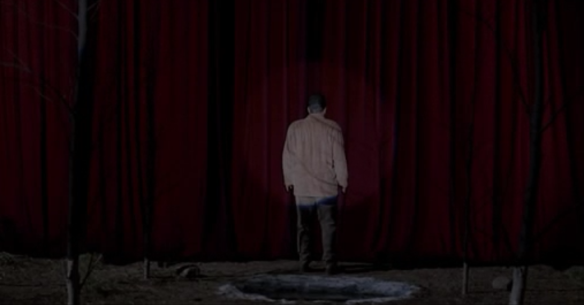 This then brings us into the throne room, as it were, of the red room, as the Romans believed, the palace of death, in the real physical underworld space under, and got to by dream space
This then brings us into the throne room, as it were, of the red room, as the Romans believed, the palace of death, in the real physical underworld space under, and got to by dream space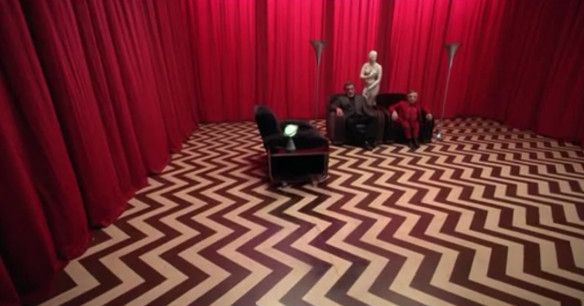 and there the dead are judged against their sins, and the evil spirits who possessed them, like in the palace rooms of the stages of Egyptian mapped deathdream space too
and there the dead are judged against their sins, and the evil spirits who possessed them, like in the palace rooms of the stages of Egyptian mapped deathdream space too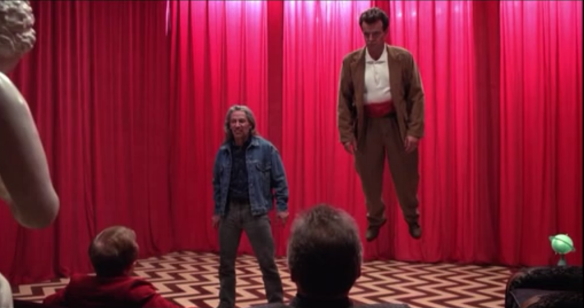 and the man from another place calls in the garambozia
and the man from another place calls in the garambozia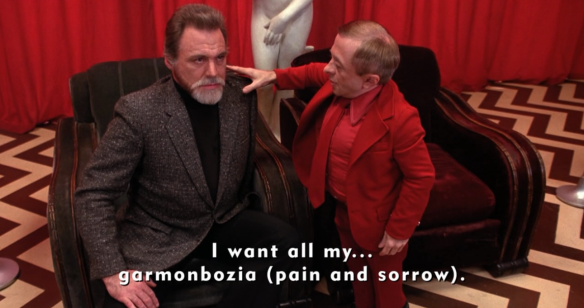 and grants to Laura, apparently, that measure of solace, not being entirely guilty of all she did, that lead to her end
and grants to Laura, apparently, that measure of solace, not being entirely guilty of all she did, that lead to her end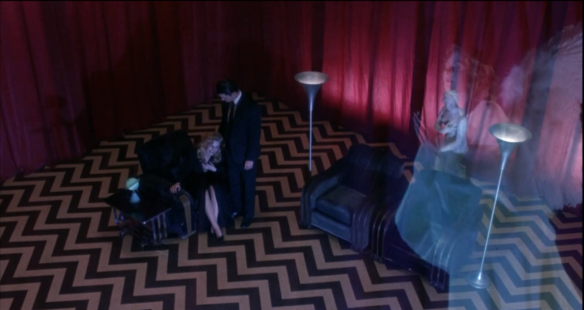 As nowhere else in American cinema, but as taken even further, even more remarkably, nine years later in Mulholland drive, Lynch infused his mis en scene with intense pagan dream theory which believed that the body could move in and out of dream space, and move through the phases of dream space, and by that movement be either protected by guardians or haunted by evil spirits. The amazing thing about his movies is that he imagines this space moving in five zones through the physical waking part of the movie to the spiritual dream part of the movie with a significant amount of overlap and passage from one to the other, and as he knows that in all cases in pagan mythology every threshold along the way was manned by a guide, or a guard, or a psychopomp or –logue, the characters in the movie and their dream life, in a way that extracts the scenario just a tad from the generally waking-sleeping binaryness of horror movies (except for a taste for fusing in late 80s British horror like Dream Demon). All this makes for a realistic mis en scene and story that while it appears to consist of encounters between characters in waking life and take place entirely in the real world, includes a series of seamless encounters between physical characters and spiritual avatars in spaces that are also palliative, dream and death spaces, and, in this way, actually places the another place of the red room in a cosmology relative to Twin Peaks that makes sense as a kind of homegrown pagan belief system of how heaven and hell relate to one another in the mind of a teenage girl. And, then, just then, in Fire Walks With Me, Lynch made triple-level instrumentalized use of pictures to get us from one zone to the other, to serve as oracle, portal and entry space from one to the other, concentrating on that more modern device of horror that he would move beyond somewhat in Mulholland Drive (2001), a decade later.
As nowhere else in American cinema, but as taken even further, even more remarkably, nine years later in Mulholland drive, Lynch infused his mis en scene with intense pagan dream theory which believed that the body could move in and out of dream space, and move through the phases of dream space, and by that movement be either protected by guardians or haunted by evil spirits. The amazing thing about his movies is that he imagines this space moving in five zones through the physical waking part of the movie to the spiritual dream part of the movie with a significant amount of overlap and passage from one to the other, and as he knows that in all cases in pagan mythology every threshold along the way was manned by a guide, or a guard, or a psychopomp or –logue, the characters in the movie and their dream life, in a way that extracts the scenario just a tad from the generally waking-sleeping binaryness of horror movies (except for a taste for fusing in late 80s British horror like Dream Demon). All this makes for a realistic mis en scene and story that while it appears to consist of encounters between characters in waking life and take place entirely in the real world, includes a series of seamless encounters between physical characters and spiritual avatars in spaces that are also palliative, dream and death spaces, and, in this way, actually places the another place of the red room in a cosmology relative to Twin Peaks that makes sense as a kind of homegrown pagan belief system of how heaven and hell relate to one another in the mind of a teenage girl. And, then, just then, in Fire Walks With Me, Lynch made triple-level instrumentalized use of pictures to get us from one zone to the other, to serve as oracle, portal and entry space from one to the other, concentrating on that more modern device of horror that he would move beyond somewhat in Mulholland Drive (2001), a decade later.